Artist Christo died today at age 84. The Gates in Central Park is one of my favorite public artworks I’ve ever experienced in person.



This site is made possible by member support. ❤️
Big thanks to Arcustech for hosting the site and offering amazing tech support.
When you buy through links on kottke.org, I may earn an affiliate commission. Thanks for supporting the site!
kottke.org. home of fine hypertext products since 1998.
Entries for May 2020
Police Erupt in Violence Nationwide. “Here are some of the ways law enforcement officers escalated the national unrest.”
Listening to Black Voices Amid Murder, Violence, Protest, and Pandemic
Hi. I wanted to take today to compile a sampling of what Black people (along with a few immigrant and other PoC voices) are saying about the recent murders by police of Breonna Taylor and George Floyd, the murder of Ahmaud Arbery, the threatening of Christian Cooper with police violence by a White woman, the protests in Minneapolis & other places, and the unequal impact of the pandemic on communities of color, as well as what Black voices have said in the past about similar incidents & situations. This is not an exhaustive list of reaction & commentary — it’s just a sample. I’m not going to add anything to these voices, but I will share a few resources at the end of the post.
Please put your urge to judge on the shelf for a minute and just listen to your fellow human beings in all of their raw, righteous, and furious anger. I am trying to listen. Is America finally ready to listen? Are you ready?
Keeanga-Yamahtta Taylor, Of Course There Are Protests. The State Is Failing Black People.
This simultaneous collapse of politics and governance has forced people to take to the streets — to the detriment of their health and the health of others — to demand the most basic necessities of life, including the right to be free of police harassment or murder.
What are the alternatives to protest when the state cannot perform its basic tasks and when lawless police officers rarely get even a slap on the wrist for crimes that would result in years of prison for regular citizens? If you cannot attain justice by engaging the system, then you must seek other means of changing it. That’s not a wish; it’s a premonition.
Keeanga-Yamahtta Taylor again reacting to “American billionaires got $434 billion richer during the pandemic”:
This looting by billionaires is what sets fires and burns down stores. You do not get one without the other.
I wish America loved black people the way they love black culture.
Martin Luther King, Jr., The Other America (via Paul Octavious):
I think America must see that riots do not develop out of thin air. Certain conditions continue to exist in our society which must be condemned as vigorously as we condemn riots. But in the final analysis, a riot is the language of the unheard. And what is it that America has failed to hear? It has failed to hear that the plight of the Negro poor has worsened over the last few years. It has failed to hear that the promises of freedom and justice have not been met. And it has failed to hear that large segments of white society are more concerned about tranquility and the status quo than about justice, equality, and humanity. And so in a real sense our nation’s summers of riots are caused by our nation’s winters of delay. And as long as America postpones justice, we stand in the position of having these recurrences of violence and riots over and over again. Social justice and progress are the absolute guarantors of riot prevention.
Bakari Sellers (click through to watch the video):
It’s just so much pain. You get so tired. We have black children. I have a 15-year-old daughter. What do I tell her? I’m raising a son. I have no idea what to tell him. It’s just, it’s hard being black in this country when your life is not valued.
Black parents talk to their children about how to deal with the police:
Ruhel Islam, a Bangladeshi immigrant and owner of Gandhi Mahal Restaurant, which burned in Minneapolis:
Let my building burn, Justice needs to be served, put those officers in jail.
In the time between Eric Garner’s “I can’t breathe” and George Floyd’s “I can’t breathe” police in the United States killed at least (AT LEAST) 5,947 people. #WeCantBreathe
Until the killing of black men, black mothers’ sons, becomes as important to the rest of the country as the killing of a white mother’s son, we who believe in freedom cannot rest.
America, where it’s okay to kneel on a black man’s neck and murder him, but it’s “unpatriotic” to kneel in protest of that murder.
#BlackLivesMatter #TakeAKnee
Luvvie Ajay, About the Weary Weaponizing of White Women Tears:
White people will never have to deal with the fact that their skin is considered a weapon but they use their skins as ammunition by using all the privileges that come with it to terrorize the world. White women use their tears as pity me bombs all the time and it often instigates Black people being punished.
I’ve traveled all over the world. And have never felt as unsafe as I do at home, in the United States.
Never.
Can we stop calling it “police brutality” it’s murder, M-U-R-D-E-R
Nikole Hannah-Jones, Yes, Black America Fears the Police. Here’s Why.:
For those of you reading this who may not be black, or perhaps Latino, this is my chance to tell you that a substantial portion of your fellow citizens in the United States of America have little expectation of being treated fairly by the law or receiving justice. It’s possible this will come as a surprise to you. But to a very real extent, you have grown up in a different country than I have.
As Khalil Gibran Muhammad, author of The Condemnation of Blackness, puts it, “White people, by and large, do not know what it is like to be occupied by a police force. They don’t understand it because it is not the type of policing they experience. Because they are treated like individuals, they believe that if ‘I am not breaking the law, I will never be abused.’”
We are not criminals because we are black. Nor are we somehow the only people in America who don’t want to live in safe neighborhoods. Yet many of us cannot fundamentally trust the people who are charged with keeping us and our communities safe.
Trump to the white people with AR-15s throwing a temper tantrum over a haircut — “Liberate”
Trump to those protesting the lack of justice in Minneapolis — “THUGS”
A whole, racist clown.
A few years ago me and dude are out and come back to his car to find it vandalized. He parked by a driveway and partially blocked it and we concluded that the owners had vandalized the car. I get pissed and go knock on the door. They don’t answer so I’m yelling!
He’s telling me to calm down and forget it but I’m pissed! A few minutes later cop car rolls by and they stop and get out. I start to tell them what happened and they walk up on him and immediately start questioning him. I interrupt and say “excuse me HIS car was vandalized!”
The cops tell me to ‘be quiet’ and just as I’m about to turn all the way up on them he turns to me and says “Baby, please…” firmly. Then he calmly answers the cops questions even though they are rude and invasive. They take his license and keep asking ridiculous questions…
“What are you all doing here?”
“Did you get into an altercation earlier tonight?”
“If I knock on these people’s door what are they going to say?”I was fuming. Now I’m nervous.
Damon Young, Thoughts on Forgiving Amy Cooper (aka ‘Darth Karen’), Who Got Fired, Banned From Central Park, and Lost Her Dog:
LOLOLOLOLOLOLOLOLOLOL…
Ibram X. Kendi (via Nicole Parker):
The greatest white privilege is life itself. People of color are being deprived of life.
They say they can’t be racist because they are northerners. They say they can’t be racist because they are progressives. They say they can’t be racist because they are Democrats.
Why are they saying they can’t be racist? Because they are racist.
Dr. Kendi for a third time (he wrote a whole book about moments like these):
It feels like Black people were running for their lives from racist terror only to run into the murderous face of COVID-19, only to start running for their lives from COVID-19 only to run into the murderous face of racist terror.
If you have trouble imagining the concept of “police abolition,” look no further than the many live experiments being played out in upper middle class white suburbs across the country where people carry on their lives with little to no interaction with law enforcement.
Ernest Owens, I Have Not Missed the Amy Coopers of the World:
I’m doing better these days because staying home alone and practicing social distancing has meant I’m avoiding many of the racist encounters that used to plague my daily life.
The video that circulated this weekend of a white woman calling the police with a false report about threats by a black man who simply asked her to leash her dog in Central Park illustrates exactly why I’m so happy to be spending more time inside.
Murder is worse than property destruction. Every single time. Don’t let capitalism fool you.
Ruby Hamad, A White Damsel Leveraged Racial Power and Failed:
The damsel-in-distress archetype probably conjures up images of delicate maidens and chivalrous gentlemen. That is precisely what it is designed to do — for white people. To people of color, and especially African-Americans who have borne the brunt of her power in the United States, the image is very different. The damsel in distress is an illusion of innocence that deflects and denies the racial crimes of white society.
J. Drew Lanham, Birding While Black:
Up until now the going has been fun and easy, more leisurely than almost any “work” anyone could imagine. But here I am, on stop number thirty-two of the Laurel Falls Breeding Bird Survey (BBS) route: a large black man in one of the whitest places in the state, sitting on the side of the road with binoculars pointed toward a house with the Confederate flag proudly displayed. Rumbling trucks passing by, a honking horn or two, and curious double takes are infrequent but still distract me from the task at hand. Maybe there’s some special posthumous award given for dying in the line of duty on a BBS route-perhaps a roadside plaque honoring my bird-censusing skills.
Tyler Merritt, Before You Call the Cops:
I’ll just say it: a lot of politicians are scared of the political power of the police, and that’s why changes to hold them accountable for flagrant killings don’t happen. That in itself is a scary problem.
We shouldn’t be intimidated out of holding people accountable for murder.
BEFORE Y’ALL KEEP GOING: Christian Cooper could have had tattoos on his face, hated birds, been smoking a blunt and listening to Future, and #CentralParkAmy WOULD HAVE STILL BEEN AS GUILTY AND RACIST AND WRONG AF FOR TERRORIZING HIM.
Enough with the respectability politics.
I really can’t shake how profoundly evil it is to tear gas folks protesting the suffocation of a man by the police during a pandemic driven by a respiratory disease.
Shenequa Golding, Maintaining Professionalism In The Age of Black Death Is….A Lot:
Your black employees are exhausted.
Your black employees are scared.
Your black employees are crying in between meetings.
Your black employees have mentally checked out.
Your black employees are putting on a performance.
Charles Blow, How White Women Use Themselves as Instruments of Terror:
At a time of so much death and suffering in this country and around the world from the Covid-19 pandemic, it can be easy, I suppose, to take any incidents that don’t result in death as minor occurrences.
But they aren’t. The continued public assault on black people, particularly black men, by the white public and by the police predates the pandemic and will outlast it. This racial street theater against black people is an endemic, primal feature of the Republic.
Specifically, I am enraged by white women weaponizing racial anxiety, using their white femininity to activate systems of white terror against black men. This has long been a power white women realized they had and that they exerted.
Michael Harriot (from this thread):
There has NEVER been a successful protest movement in modern history that succeeded without violence.
Not Christianity. Not democracy. Not civil rights.
The choice is, which side is going to do the donate their blood?
We’re damn near out of blood to give.
So, if you want to change the system, history has repeatedly told us how to do it.
Burn.
That.
Shit.
Down.And amen, motherfuckers.
James Baldwin (see also How to Cool It and, like, everything else Baldwin has ever written or said):
The reason that black people are in the streets has to do with the lives they’re forced to lead in this country. And they’re forced to lead these lives by the indifference and the apathy and a certain kind of ignorance — a very willful ignorance — on the part of their co-citizens.
Several people on social media have pointed to this list of 75 Things White People Can Do for Racial Justice, including several organizations you can donate to. Ibram X. Kendi compiled an antiracist reading list. I am not any sort of expert, but I personally have found much understanding in listening to the Seeing White podcast, reading Isabel Wilkerson’s The Warmth of Other Suns, and watching Eyes on the Prize, I Am Not Your Negro, & OJ: Made in America among other things. Thanks to everyone listed here for sharing their words and works with us.
Iran’s Qajar Dynasty, Modernized
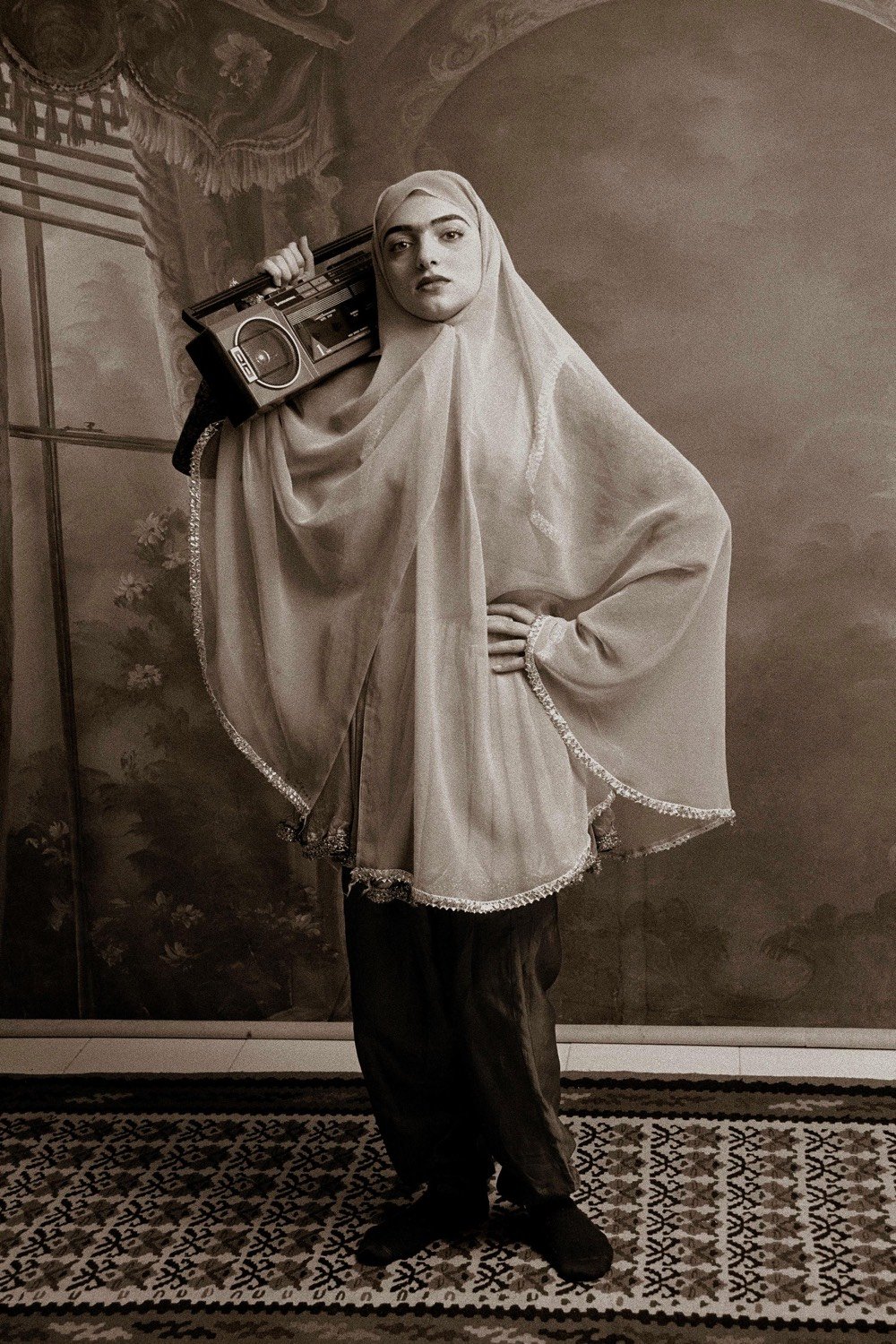

For her photo series Qajar, Iranian photographer Shadi Ghadirian styled her subjects and their backgrounds as they would have appeared in portraits taken during Iran’s Qajar Dynasty in the 19th century. But each subject is also posed with a contemporary object like a boombox, bicycle, soda can, or vacuum cleaner. Ghadirian says of her work: “My pictures became a mirror reflecting how I felt: we are stuck between tradition and modernity.”
30 Movies That Are Unlike Anything You’ve Seen Before, incl. The Act of Killing, Just Another Girl on the I.R.T., Morvern Callar, and The Portrait of a Lady.
More Than 100,000 People Have Died Of The Coronavirus In The US. “Public health experts say the real number of infections and deaths from COVID-19 is likely much higher than the official count.”
Adobe is offering their entire 99U Conference online this year for free (it’s regularly ~$1000). Talks, classes, and workshops from folks like Kelli Anderson, Taeyoon Choi, Yancey Strickler, and Michelle Rial.
Black Photo Booth
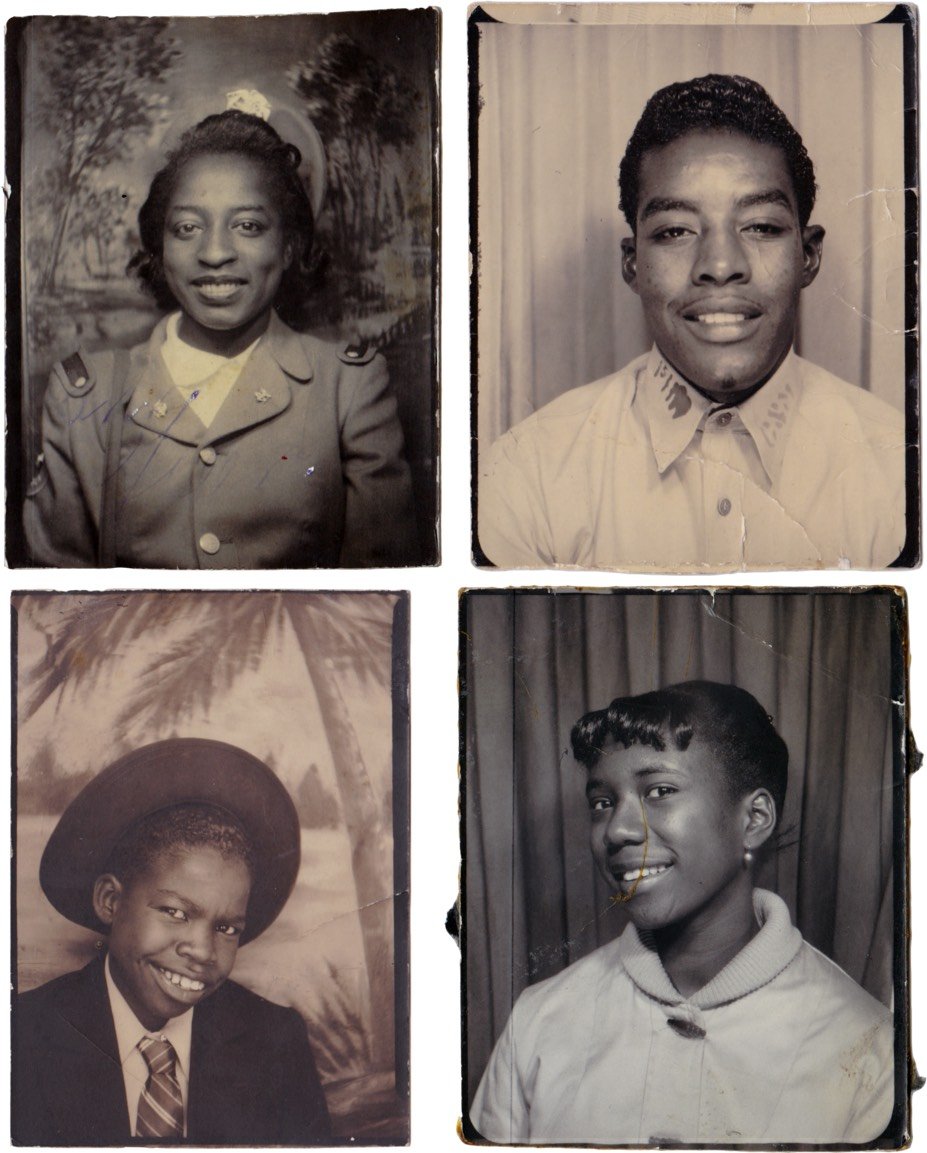
Mariame Kaba has been collecting photo booth portraits of black people for years and built a website that displays a selection of them.
I’ve been collecting found images of Black people for many years. Some of my favorites are photo booth portraits. They often show Black people of different ages, genders, classes in serious and also playful poses. Usually, there are no names listed so these anonymous people invite the viewer to use their imagination in crafting a story about their lives.
Protestors Criticized For Looting Businesses Without Forming Private Equity Firm First. “It’s disgusting to put workers at risk by looting. You do it by chipping away at their health benefits and eventually laying them off.”
Tonight’s Classic Radiohead Concert Is From 1994
Since early April, Radiohead has been putting video of one classic concert a week up on YouTube (playlist here). Tonight’s show, which starts streaming at 5pm ET, is from a really interesting point in the band’s evolution. In May 1994, Radiohead had released only one album (Pablo Honey) and no one knew whether they were going to be anything more than a one-hit wonder. At the time, the group was in the midst of recording The Bends and the setlist contains several songs from that album, including Fake Plastic Trees, The Bends, My Iron Lungs, and Just.
The release of The Bends and the reception to it established Radiohead as a group to be taken seriously and set the stage for OK Computer launching them into the critical stratosphere. As Jonny Greenwood later recounted: “That’s when it started to feel like we made the right choice about being a band”. Really excited to watch this one.
Birding While Black. “I’ve seen a shit-ton of birds from sea level to alpine tundra. But as a black man in America I’ve grown up with a profile.”
75 Things White People Can Do for Racial Justice. “40. Don’t be silent about that racist joke. Silence is support.”
Welcome to American Capitalism
From an April 17th Facebook post by Paul Field, a succinct summary of how the pandemic exposes American deficiencies. It’s tough to not just quote the whole thing, so here’s the beginning:
Everyone is entitled to their own opinion, but you need to know how silly you look if you post some variation of, “Welcome to Socialism…”
You are not seeing Socialism. What you are seeing is one of the wealthiest, geographically advantaged, productive capitalist societies in the world flounder and fail at its most basic test. Taking care of its people.
This crisis is not about the virus.
This crisis is about the massive failure of our, “Booming economy,” to survive even modest challenges. It is about the market dissonance of shortages in stores, even as farmers/producers destroy unused crops and products. This crisis is about huge corporations needing an emergency bailout within days of the longest Bull Market in our history ending and despite the ability to borrow with zero percent interest rates.
The pandemic has revealed that American democracy and our economic system is extremely fragile. Ok, unless you’re wealthy, in which case you’re going to be fine, all part of the plan, etc.
Postmastectomy Tattooing Helps Women with Breast Cancer Heal


David Allen is a tattoo artist who does postmastectomy tattooing. He works with women who survive breast cancer to design and implement tattoos that cover scarring from mastectomies, transforming what might be seen as a destructive disfigurement into something creative and beautiful. Here’s Allen writing for The Journal of the American Medical Association (abstract):
I am a tattoo artist who works with women after they’ve had mastectomies to transform their sense of disfigurement and loss of control into feelings of beauty and agency. On a good day, I can heal with my art.
The women with breast cancer with whom I work share a feeling that they’ve been acted upon — by cancer, the health industrial complex and its agents, the sequelae of their treatments. Their physical and psychological points of reference are destabilized, having changed so quickly. A successful tattooing experience establishes a new point of reference, a marker that’s intimately theirs that replaces their sense of rupture and damage with an act of creation and, in my work, images of natural life.
Allen even does “solidarity tattoos” for his clients’ partners and friends. You can see more of his postmastectomy work on Instagram.
NVIDIA trained an AI to not only play Pac-Man but to generate a fully functional version of the game. “We were blown away when we saw the results, in disbelief that AI could recreate the iconic PAC-MAN experience without a game engine.”
NASA & SpaceX Scheduled to Launch Astronauts Into Orbit From US Soil for First Time in 9 Years
NASA and SpaceX are scheduled to launch two astronauts into orbit this afternoon from the United States for the first time in nine years. The launch is scheduled to take place at 4:33 p.m. EDT. We’ll be watching for sure!
SpaceX is targeting Wednesday, May 27 for Falcon 9’s launch of Crew Dragon’s second demonstration (Demo-2) mission from Launch Complex 39A (LC-39A) at NASA’s Kennedy Space Center in Florida. This test flight with NASA astronauts Bob Behnken and Doug Hurley on board the Dragon spacecraft will return human spaceflight to the United States.
The mission is also the first time a private company will carry humans into orbit. You can watch the launch in the stream above with commentary (the coverage has already started — the astronauts just suited up and are on their way to launchpad 39A and now Kelly Clarkson is singing the National Anthem from her house) or with just the audio feed from Mission Control. And you can read more about the mission here.
Update: The launch got scrubbed for today — poor weather conditions. The next launch window is Saturday, May 30 at 3:22pm ET.
Full-Day Rotation of the Earth Around a Stationary Sky
Last year I posted a pair of videos showing a sky-stabilized rotation of the Earth around the starry sky. Because the Earth is our vantage point, we’re not used to seeing this view and it’s pretty trippy.
Now Bartosz Wojczyński has created a video showing full-day rotation of the Earth with footage shot in Namibia. The rotation is sped up to take only 24 seconds and is repeated 60 times to simulate about 2 months of rotation. I find this very relaxing to watch, like I’m riding in a very slow clothes dryer.
See also The Entire Plane of the Milky Way Captured in a Single Photo.
Holy crap, they still make Hypercolor shirts?! “A heat activated unisex color changing tshirt for men that changes color when you touch it or by your surrounding heat.”
Errol Morris’s Next Documentary Is About Psychedelic Guru Timothy Leary
The next documentary film from Errol Morris is about LSD advocate Timothy Leary and will debut on Showtime later in the year. The film is still untitled but is based on a memoir by Joanna Harcourt-Smith called Tripping the Bardo with Timothy Leary: My Psychedelic Love Story.
A FILM BY ERROL MORRIS (w/t) asks the question why Leary, the High Priest of LSD, became a narc in 1974 and seemingly abandoned the millions he urged to turn on, tune in and drop out. Was his “perfect love” Joanna Harcourt-Smith a government pawn, as suggested by Allen Ginsberg? Or was she simply a rich, beautiful, young woman out for the adventure of a lifetime? Morris and Harcourt-Smith will reexamine this chaotic period of her life and explore the mystery of the Leary saga: his period of exile, reimprisonment and subsequent cooperation with the authorities. Devotion or selfishness? Perfect love or outright betrayal? Destiny or manipulation?
This is Morris’s second foray into the topic of LSD — his 2017 Netflix series Wormwood explored the use of the drug by the CIA.
“New” Philip Glass Music, Rediscovered After 50 Years

In 1970, right in the middle of his minimalist period, Philip Glass composed a work called Music in Eight Parts. It was performed a few times and then lost to the sands of time.
It’s theorized that after Glass’s 1975 opera Einstein on the Beach landed the composer in a fair amount of debt, Glass was forced to sell a number of scores. In Glass’s archive, only fragmentary sketches of MUSIC IN EIGHT PARTS remained as evidence of the piece’s existence. Glass “never intended this early music to last” and yet these pieces have ended up being some of his most appreciated. MUSIC IN EIGHT PARTS is immediately recognizable as being of Glass’s minimalist musical language in full stride and it is played with absolute mastery by the specialists of this repertoire.
The manuscript was rediscovered in 2017 and plans were made to perform the work in a series of European concerts. The pandemic intervened, so several members of the Philip Glass Ensemble each recorded their parts at home and they’ve released a recording online (Spotify, Apple Music).
You can see some of the individual recordings in the middle part of this video:
The cover art is by Sol LeWitt, who used to send Glass random $1000 checks. See also a writeup of the music in the NY Times, listen to a snippet of an archival performance of the piece from the 70s, and the manuscript itself, which sold at auction in 2017 for $43,750.
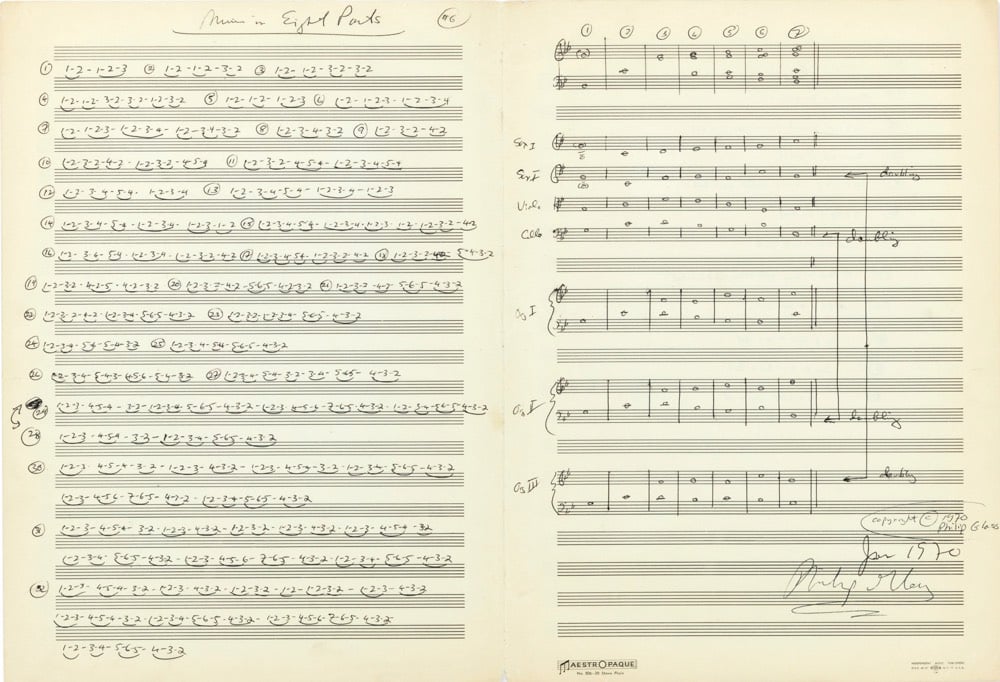
A short summary of the current research: what we know and don’t yet know about Covid-19. “We don’t yet know how long immunity lasts. Once you get it once, will you be immune for a month? A year? A lifetime?”
Tomorrow NASA is launching astronauts into orbit from the US for the first time since 2011. They’ll ride in a spacecraft built by SpaceX, which will become the first private company to launch humans into space.
Knight Rider for 8 Cellos
This is a video of the Knight Rider theme song arranged for 8 cellos by Samara Ginsberg. You’re either the type of person who can’t wait to click on a link that says “Knight Rider for 8 cellos” or you are not. When I was in college, a friend who DJ’d campus parties used to throw the Knight Rider theme on and people always went nuts for it. Because it BANGS.
Japan has had success against Covid-19 so far without a national lockdown or mass testing. How did they do it? Early, aggressive, and competent contact tracing & “an expert-led approach” are two reasons.
A low dispersion factor of SARS-CoV-2 may indicate that most people don’t spread the disease. “We are certainly seeing a lot of concentrated clusters where a small proportion of people are responsible for a large proportion of infections.”
The Country with the Best Covid-19 Response? Mongolia.
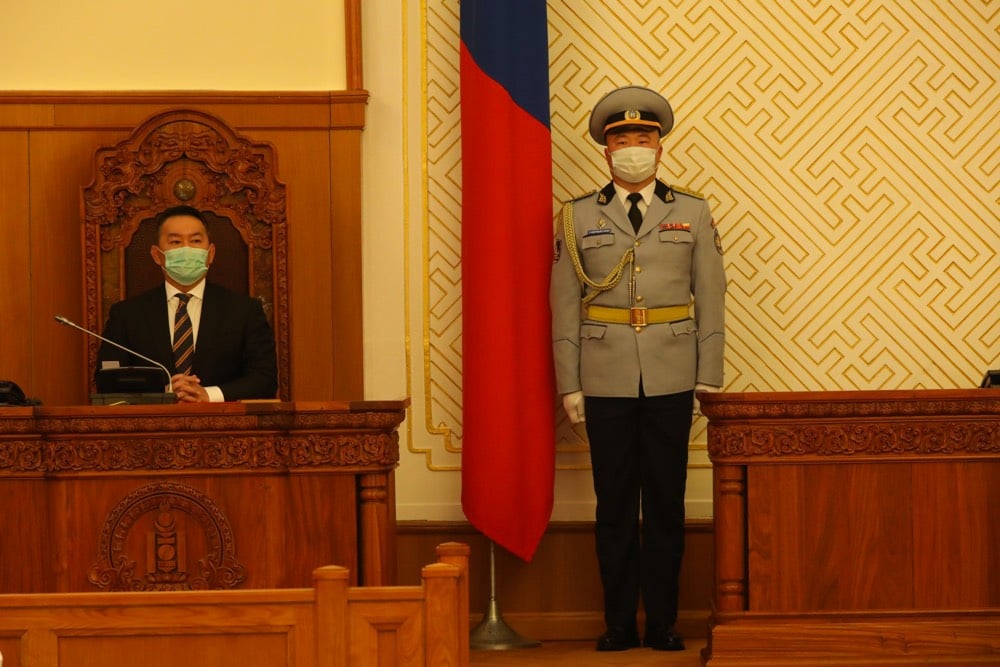
Several countries have had solid responses to the Covid-19 pandemic: Taiwan, South Korea, New Zealand, and Hong Kong. But Indi Samarajiva thinks we should be paying much more attention to Mongolia, a country of 3.17 million people where no one has died and no locally transmitted cases have been reported.1 Let’s have that again: 3.17 million people, 0 local cases, 0 deaths. How did they do it? They saw what was happening in Wuhan, coordinated with the WHO, and acted swiftly & decisively in January.
Imagine that you could go back in time to January 23rd with the horse race results and, I dunno, the new iPhone. People believe you. China has just shut down Hubei Province, the largest cordon sanitaire in human history. What would you scream to your leaders? What would you tell them to do?
You’d tell them that this was serious and that it’s coming for sure. You’d tell them to restrict the borders now, to socially distance now, and to get medical supplies ready, also now. You’d tell them to react right now, in January itself. That’s 20/20 hindsight.
That’s exactly what Mongolia did, and they don’t have a time machine. They just saw what was happening in Hubei, they coordinated with China and the WHO, and they got their shit together fast. That’s their secret, not the elevation. They just weren’t dumb.
When you go to World In Data’s Coronavirus Data Explorer and click on “Mongolia” to add their data to the graph, nothing happens because they have zero reported cases and zero deaths. They looked at the paradox of preparation — the idea that “when the best way to save lives is to prevent a disease rather than treat it, success often looks like an overreaction” — and said “sign us up for the overreacting!”
Throughout February, Mongolia was furiously getting ready - procuring face masks, test kits, and PPE; examining hospitals, food markets, and cleaning up the city. Still no reported cases. Still no let-up in readiness. No one was like “it’s not real!” or “burn the 5G towers!”
The country also suspended their New Year celebrations, which are a big deal in Asia. They deployed hundreds of people and restricted intercity travel to make sure, though the public seemed to broadly support the move.
Again — and I’ll keep saying this until March — there were still NO CASES. If you want to know how Mongolia ended up with no local cases, it’s because they reacted when there were no local cases. And they kept acting.
For example, when they heard of a case across the border (ie, not in Mongolia) South Gobi declared an emergency and put everyone in masks. The center also shut down coal exports — a huge economic hit, which they took proactively.
As you can see, at every turn they’re reacting like other countries only did when it was too late. This looked like an over-reaction, but in fact, Mongolia was always on time.
I have to tell you true: I got really upset reading this. Like crying and furious. The United States could have done this. Italy could have done this. Brazil could have done this. Sweden could have done this. England could have done this. Spain could have done this. Mongolia listened to the experts, acted quickly, and kept their people safe. Much of the rest of the world, especially the western world — the so-called first-world countries — failed to act quickly enough and hundreds of thousands of people have needlessly died and countless others have been left with chronic health issues, grief, and economic chaos.
If you look at the list of cases at the bottom of this article (translated by Google), you can see that every reported case is from people coming into the country who were tested and quarantined.↩
J.K. Rowling has posted online the first two chapters of a new fairy tale called The Ickabog (unrelated to the Wizarding World btw). A book version will be published in November w/ all royalties going to Covid-19 relief.
Squirt Gun Baptisms


Social distancing priests are performing baptisms with water guns. This is definitely a metaphor for something but I don’t know what. Or like something out of a Tarantino screwball comedy — “And you will know my name is the Lord when I lay my Super Soaker CPS 2000 upon thee…” Love the social distancing though. More here.
What happens if Trump tries to cancel the election, shuts down urban polling places, contests the election results, or refuses to leave the White House? He was always going to attempt this stuff – the pandemic just makes it waaaay easier.
US Covid-19 Death Toll Nears 100,000
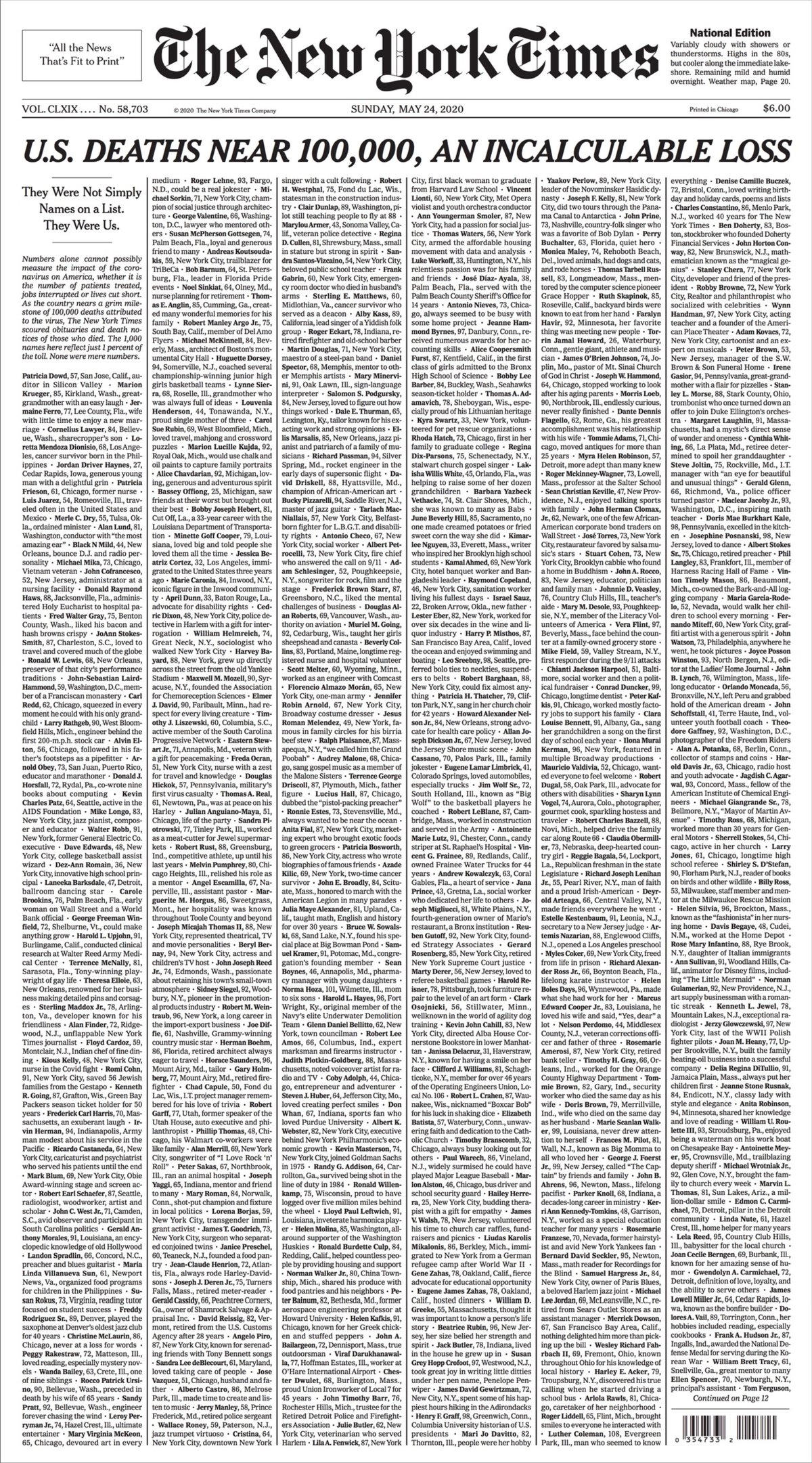
That’s the front page of the NY Times today, listing the names of hundreds of the nearly 100,000 Americans who have died from Covid-19 (the full listing is of ~1000 names and continues inside the paper).
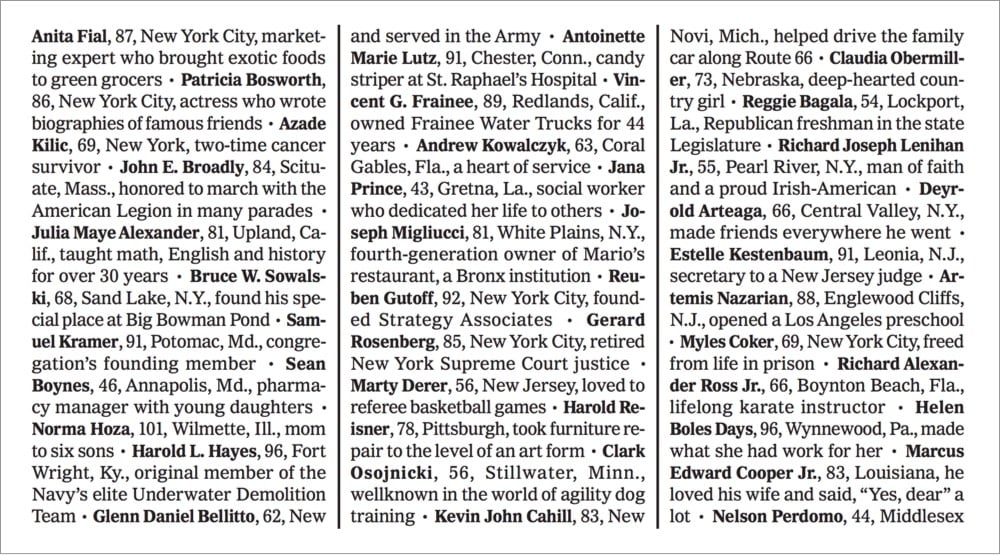
Here’s a more readable PDF version and an online version that scrolls and scrolls and scrolls. They compiled the list by going through obituaries from local newspapers from around the countries.
Putting 100,000 dots or stick figures on a page “doesn’t really tell you very much about who these people were, the lives that they lived, what it means for us as a country,” Ms. Landon said. So, she came up with the idea of compiling obituaries and death notices of Covid-19 victims from newspapers large and small across the country, and culling vivid passages from them.
Alain Delaquérière, a researcher, combed through various sources online for obituaries and death notices with Covid-19 written as the cause of death. He compiled a list of nearly a thousand names from hundreds of newspapers. A team of editors from across the newsroom, in addition to three graduate student journalists, read them and gleaned phrases that depicted the uniqueness of each life lost:
“Alan Lund, 81, Washington, conductor with ‘the most amazing ear’ … “
“Theresa Elloie, 63, New Orleans, renowned for her business making detailed pins and corsages … “
“Florencio Almazo Morán, 65, New York City, one-man army … “
“Coby Adolph, 44, Chicago, entrepreneur and adventurer … “
Every one of these names was a person with a whole life behind them and so much more to come. Each has a family and friends who are mourning them. Here are a few more of their names and short stories:
Romi Cohn, 91, New York City, saved 56 Jewish families from the Gestapo.
Jermaine Ferro, 77, Lee County, Fla., wife with little time to enjoy a new marriage.
Julian Anguiano-Maya, 51, Chicago, life of the party.
Alan Merrill, 69, New York City, songwriter of “I Love Rock ‘n’ Roll.”
Lakisha Willis White, 45, Orlando, Fla., was helping to raise some of her dozen grandchildren.
In the past five months, more Americans have died from Covid-19 than in the decade-plus of the Vietnam War and the death toll is a third of the number of Americans who died in World War II. When this is over (whatever that means), the one thing we cannot do is forget all of these people. And we owe to them to make this mean something.
Wearing masks is a public health issue. “No shoes, no shirt, no mask, no service.”
“SARS-CoV-2 blocks one virus-fighting set of genes but allows another set to launch, a pattern never seen with other viruses”, which allows it to easily spread in the lungs. But, this may also point the way towards a preventative treament.
The 2020 Minnesota State Fair has been cancelled “for only the sixth time in a history that predates the US Civil War.” The last time it was cancelled was in 1946 because of the polio epidemic.
This is weird: John Krasinski sold Some Good News to ViacomCBS “following a massive bidding war” and will no longer host the show. All good things, etc.
A profile of LearnedLeague, the invite-only online trivia tournament, and its founder. “Twelve people have walked on the Moon; only three have won the Commissioner T.A. Integrity Scarf as LearnedLeague Champion.”
Bill Gates’ Pandemic Summer Reading List
As he does every year, Bill Gates has shared his reading list for this summer. This time around, he’s included more than his usual five picks and many of the recommendations have a connection to the ongoing pandemic.
Of The Choice by Edith Eva Eger, he says:
This book is partly a memoir and partly a guide to processing trauma. Eger was only sixteen years old when she and her family got sent to Auschwitz. After surviving unbelievable horrors, she moved to the United States and became a therapist. Her unique background gives her amazing insight, and I think many people will find comfort right now from her suggestions on how to handle difficult situations.
He also recommends The Great Influenza by John Barry, Good Economics for Hard Times by Abhijit Banerjee and Esther Duflo, and The Headspace Guide to Meditation and Mindfulness by Andy Puddicombe.
For years, I was a skeptic about meditation. Now I do it as often as I can — three times a week, if time allows. Andy’s book and the app he created, Headspace, are what made me a convert. Andy, a former Buddhist monk, offers lots of helpful metaphors to explain potentially tricky concepts in meditation. At a time when we all could use a few minutes to de-stress and re-focus each day, this is a great place to start.
Gates also recommended some TV shows and movies — Netflix’s Pandemic but also Ozark. He read Cloud Atlas recently — I wonder if he’s seen the movie by the Wachowskis (which is underrated IMO)?
I am a simple potato guardian who needs my Second Amendment rights. “I can’t believe the governor would come for our Second Amendment rights. No potato will be safe then. It’s monstrous.”
Taking advantage of the empty roads of the pandemic lockdown, the record for the fastest car trip across the US has been broken several times. The current record is less than 26 hours (which means they averaged 107mph across the entire US).
Advice for getting children & their grandparents back together again. “Once you’re confident in your family’s quarantine vigilance for 14 days, it’s less risky to visit an older family member. But go with a plan.”
After The Empire Strikes Back opened in 1980 in a few theaters in 70mm, George Lucas *changed the end of the movie* before its wider 35mm release 3 weeks later. “I don’t wanna tell you this. We need some more shots for Empire.”
Just When You Thought It Was Safe to Go Back Into the Water…
As summer ramps up in North America, people are looking to get out to enjoy the weather while also trying to keep safe from Covid-19 infection. Here in Vermont, I am very much looking forward to swim hole season and have been wondering if swimming is a safe activity during the pandemic. The Atlantic’s Olga Khazan wrote about the difficulty of opening pools back up this summer:
The coronavirus can’t remain infectious in pool water, multiple experts assured me, but people who come to pools do not stay in the water the entire time. They get out, sit under the sun, and, if they’re like my neighbors, form a circle and drink a few illicit White Claws. Social-distancing guidelines are quickly forgotten.
“If someone is swimming laps, that would be pretty safe as long as they’re not spitting water everywhere,” says Angela Rasmussen, a virologist at Columbia University. “But a Las Vegas-type pool party, that would be less safe, because people are just hanging out and breathing on each other.”
This story by Christopher Reynolds in the LA Times focuses more on transmission via water (pool water, salt water, river/lake water).
“There is no data that somebody got infected this way [with coronavirus],” said professor Karin B. Michels, chair of UCLA’s Department of Epidemiology, in a recent interview.
“I can’t say it’s absolutely 100% zero risk, but I can tell you that it would never cross my mind to get COVID-19 from a swimming pool or the ocean,” said Paula Cannon, a professor of molecular microbiology and immunology at USC’s Keck School of Medicine. “It’s just extraordinarily unlikely that this would happen.”
As long as you keep your distance of course:
Rather than worry about coronavirus in water, UCLA’s Michels and USC’s Cannon said, swimmers should stay well separated and take care before and after entering the pool, lake, river or sea.
“I would be more concerned about touching the same lockers or surfaces in the changing room or on the benches outside the pool. Those are higher risk than the water itself,” Michels said. “The other thing is you have to maintain distance. … More distance is always better.”
Sorta related but not really: ten meters is definitely more distance.
Carly Rae Jepsen Uses My Silkscreen Font in a Promo Video
This morning, Carly Rae Jepsen released a new album called Dedicated Side B (stream here). Amidst rumors of fresh music, the pop star had been teasing fans with its release all week, including this video of a simulated chat posted to Twitter and Instagram yesterday.
Long-time readers will recognize that the chat text is displayed with typeface called Silkscreen, which I designed back in 1999, an era of small monitors and even smaller fonts.

Back in the day, Britney Spears used Silkscreen on her website, and now it’s come (sorta) full circle with Jepsen. Silkscreen pops up here and there every few months, and I’m glad to see people are still getting some use out of it. It was retro when I made it and now its retro-ness is retro. Culture is fun! (thx to @desdakon for spotting this)
The Top 50 Sports Documentaries
On the occasion of ESPN’s hit documentary The Last Dance finishing up, Axios’ Kendall Baker shared his list of the top 50 sports documentaries of all time.
It’s unsurprising that Hoop Dreams comes out on top — I need to make some time to watch that again. OJ: Made in America comes in at #2 and is indeed excellent, one of the best things I’ve seen on TV in recent years. But is it actually a sports documentary? It’s about a guy who used to play sports… The Last Dance finishes in third place; I haven’t seen it yet1 but my guess is that’s too high, especially considering Jordan had a lot of control over the finished product.
Loved seeing some of my other favorites on there too: Senna, When We Were Kings, Pumping Iron, The King of Kong: A Fistful of Quarters, Dogtown and Z-Boys, and Minding the Gap (which should have been way higher on the list). (via @mikeindustries)
I don’t know if this is happening to you during all of this, but I have limited energy at the end of the day for any form of televisual entertainment that’s supposed to be “good”. So even though I was a massive Michael Jordan and Chicago Bulls fan in the 90s, I haven’t worked up the energy to tackle this yet. I guess part of me is also anxious about how invested I was in that story back then and what it might dredge up for me, feelings-wise.↩
Dad, How Do I…?
When he was a kid, Rob Kenney had a rough family life and grew up without stable parents around to teach him how to do common household chores. He and his wife successfully raised two children and Kenney decided to use his parenting experience to help those who may be lacking parental guidance. He’s started a YouTube channel called “Dad, how do I?” that offers “practical ‘dadvice’ for every day tasks” like how to fix a running toilet, how to check the oil in your car, and how to shave your face.
My god, the dad joke he tells at the beginning of the running toilet video is just *chef’s kiss* perfect.
Inside the Epicenter of the Pandemic Baking Boom at King Arthur Flour

Marker’s David Freedman has a great look at how Vermont’s own King Arthur Flour has dealt with a massive increase in demand for their best-in-class flour and other challenges during the pandemic. The piece is a textbook example of what Tim Carmody calls the systemic sublime.
The company knew something weird was going on when they noticed a 600% sales jump almost overnight and started seeing different kinds of questions coming into their consumer call center.
So tricky and specific are some of the bread-baking questions that even though Ely is one of the bread specialists working the hotline, she sometimes puts callers on hold and yells over the cubicle walls to colleagues for second opinions.
But in early March, Ely noticed a change in the questions. Partly it was an increase in the sheer number of calls, a jump that seemed more sudden and pronounced than the normal mild pre-Easter build-up. But even stranger was how many of the callers seemed, well, clueless. How do you tell if bread is done? Do I really need yeast? And strangest of all: What can I use instead of flour?
In a matter of weeks, the employee-owned company transformed several aspects of their business and tripled their flour output in order to keep up with the demand.
As a first step to ramping up the flow of flour to consumers, King Arthur added one to two shifts at all its facilities and contracted with an additional fulfillment center. It shifted most of its long-distance product transportation from rail to trucks, which are more expensive per bag but add speed and flexibility. It stopped international sales to divert all incoming inventory to U.S. customers. To make shipping operations more efficient and get orders out the door faster, the company switched to all “ship-complete” shipping — that is, if one item in a multi-item order was temporarily out of stock, the entire order was held until the item was back in stock.
The company also managed to find a new partner that could mill and bag more flour. The wrinkle was that the partner was only set up to fill three-pound plastic bags, not King Arthur’s five- and 10-pound paper bags. So King Arthur quickly whipped up a new three-pound plastic bag and threw it up on the website as a new product. That move alone would add up to a half-million new units a month to the company’s shipments.
The company has also done right by their employee-owners:
Altogether, three-quarters of the company’s employees were sent home. In many cases, the work went with them, as was the case with the Baker’s Hotline, and with most managers. Many of those whose jobs couldn’t be performed at home were trained to help out with tasks that could. So far, not a single employee has been furloughed; everyone is being paid — including 12 employees who stay busy sewing masks for other employees.
They’ve helped out companies they supply as well:
While home baking was taking off, bakeries were being closed down, sharply reducing demand for the big bags of flour. (To help keep some of them afloat, the company has spent $30,000 so far during the pandemic paying some of its bakery customers around the country — including Empire Baking — to bake bread and donate it to local good causes. Its own bakers have been doing the same for essential workers and those in need in Norwich.)
And I love the photos that accompany the article by Stephanie Gonot — that must have been a fun & messy photoshoot to do at home. (via @robinsloan)
When developing new typefaces, pangrams like “the quick brown fox jumps over the lazy dog” are bad for testing out real-world letter combinations & letter frequency. So Jonathan Hoefler wrote some new text that includes dozens of useful common combos.
Ed Yong on America’s Patchwork Pandemic. “In a pandemic, the actions of 50 uncoordinated states will be less than the sum of their parts. Only the federal government has pockets deep enough to fund the extraordinary public-health effort now needed.”
Nature By Numbers
This lovely short film by Cristóbal Vila shows how the simple Fibonacci sequence manifests itself in natural forms like sunflowers, nautilus shells, and dragonfly wings.
See also Arthur Benjamin’s TED Talk on the Fibonacci numbers and the golden ratio and the Fibonacci Shelf. (via @stevenstrogatz)
In less than a week, a grad student casually solved a famous math problem that had gone unsolved for decades. When she told her advisor: “He started yelling, ‘Why aren’t you more excited?’”
Map of Pangaea with Modern-Day Borders
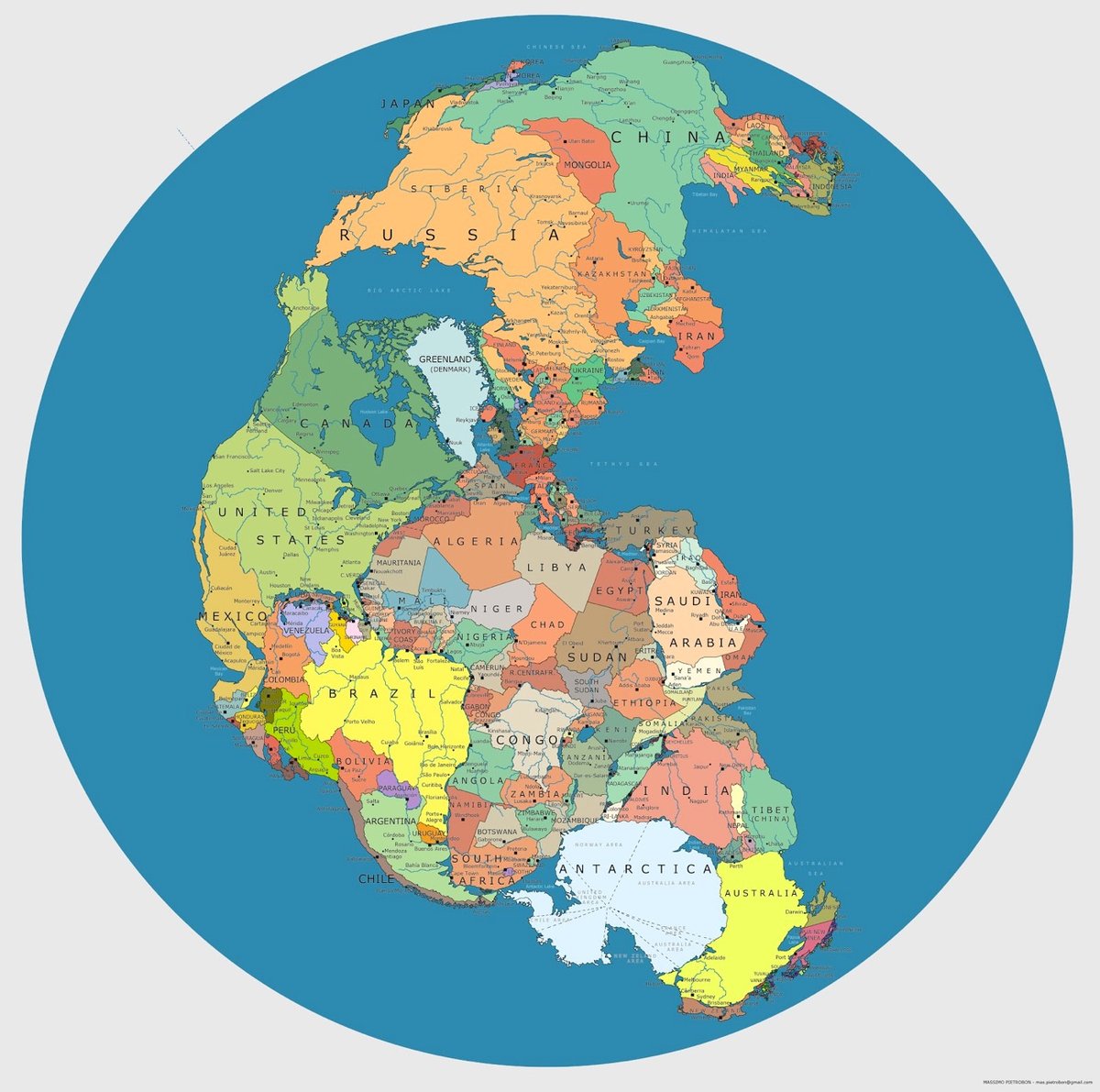
Pangaea is a supercontinent that formed on Earth about 335 million years ago and began to break up about 175 million years ago, eventually forming the familiar continents of today. Massimo Pietrobon made a map that shows where our modern country borders would appear on Pangaea. Check out the full-size version here.
See also Locate Modern Addresses on Earth 240 Million Years Ago. (via @owacle)
How to Think About Freedom and Liberty During a Pandemic
After 2+ months of lockdown in most areas, a small minority of Americans want our country to go back to “normal” despite evidence and expert advice to the contrary. They want to get haircuts, not wear masks in public, go to crowded beaches, and generally go about their lives. These folks couch their desires in terms of freedom & liberty: the government has no right to infringe on the individual freedoms of its citizens.
But governments routinely do just that for all kinds of good reasons — e.g. you can’t murder someone just because you feel like it — and as Johns Hopkins’ public health historian Graham Mooney points out, there’s a precedent for a different way of thinking about freedom in the context of public health.
In response to these vehement appeals to individual freedom, public-health leaders in London, Liverpool, Manchester and elsewhere developed a powerful counterargument. They too framed their argument in terms of freedom — freedom from disease. To protect citizens’ right to be free from disease, in their view, governments and officials needed the authority to isolate those who were sick, vaccinate people, and take other steps to reduce the risk of infectious disease.
One of the most important reformers was George Buchanan, the chief medical officer for England from 1879 to 1892. He argued that cities and towns had the authority to take necessary steps to ensure the communal “sanitary welfare.” He and other reformers based their arguments on an idea developed by the 19th-century English philosopher John Stuart Mill, who is, ironically, remembered largely as a staunch defender of individual liberty. Mill articulated what he called the “harm principle,” which asserts that while individual liberty is sacrosanct, it should be limited when it will harm others: “The sole end for which mankind are warranted, individually or collectively, in interfering with the liberty and action of any of their number, is self-protection,” Mill wrote in On Liberty in 1859. Public-health reformers argued that the harm principle gave them the authority to pursue their aims.
An essay published in The Lancet in 1883 sums up this view nicely: “We cannot see that there is any undue violation of personal liberty in the sanitary authority acting for the whole community, requiring to be informed of the existence of diseases dangerous to others. A man’s liberty is not to involve risk to others,” the author wrote. “A man with smallpox has the natural liberty to travel in a cab or an omnibus; but society has a right that overrides his natural liberty, and says he shall not.”
Dr. Seuss Reimagined for the Pandemic

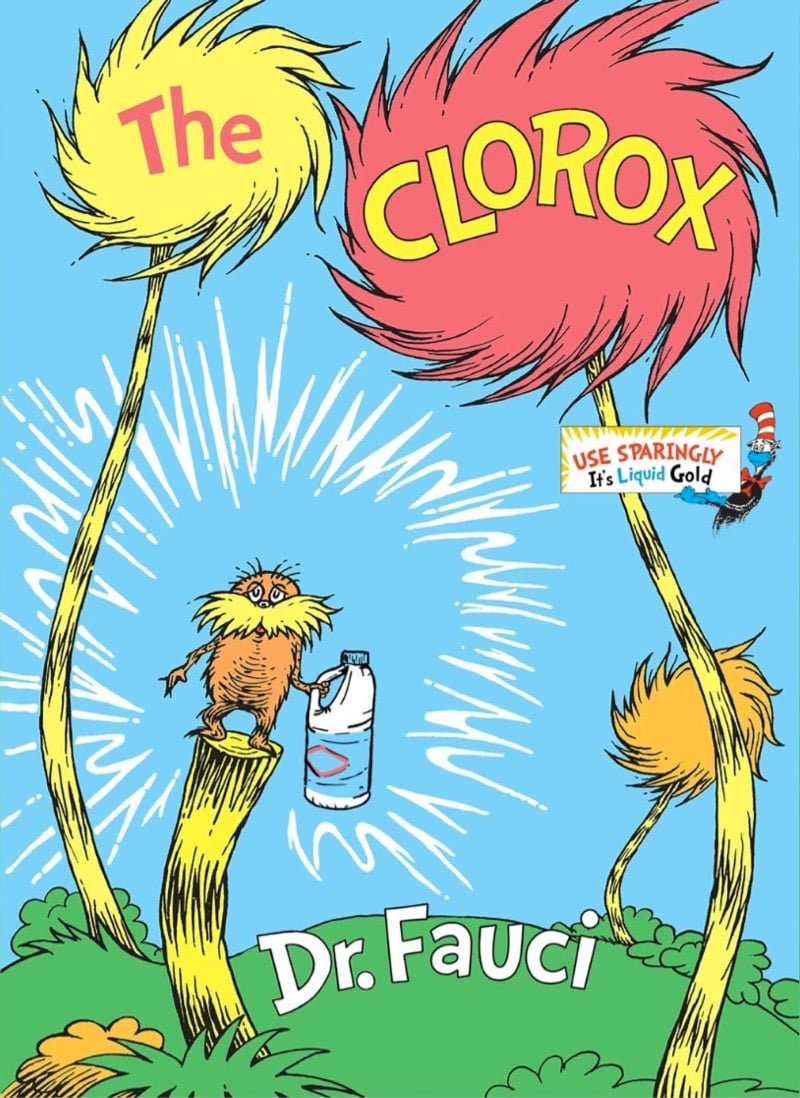
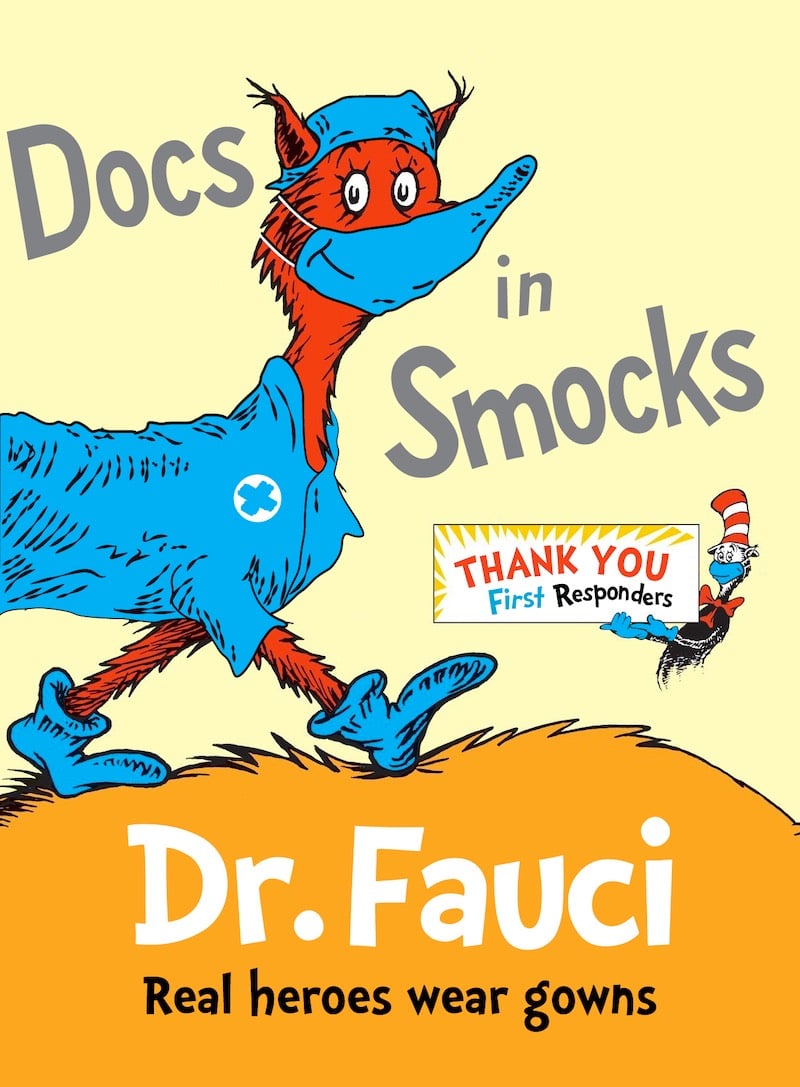
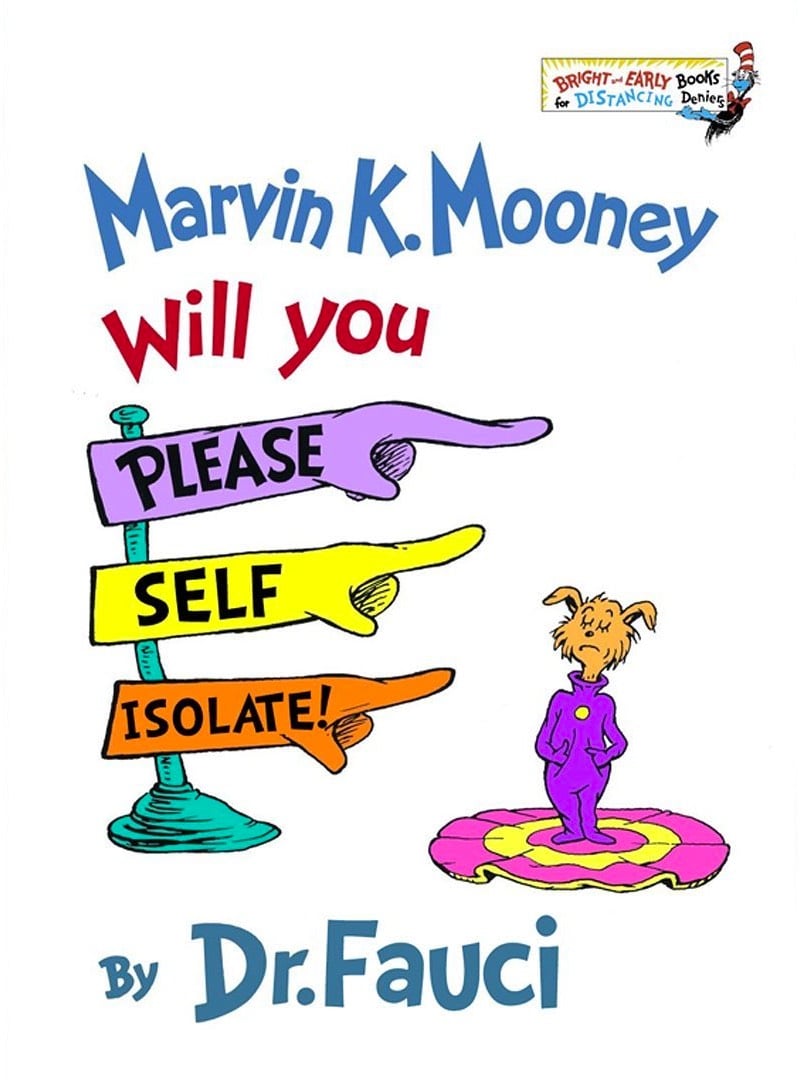
Designer Jim Malloy has reimagined the books of Dr. Seuss for the coronavirus age by altering the titles & cover illustrations and changing the author to “Dr. Fauci”. You can check out the results on Instagram and in this Instagram Story. (via print)
A Succession insult generator. “FitBit moron whatever people.” “He looks waxy, like an unshaven candle.”
Beastie Boys Videos Remastered in HD
In celebration of the documentary Beastie Boys Story coming out, the Beastie Boys and their record label have remastered dozens of the group’s music videos in HD and uploaded them to YouTube. The videos include heavy-hitters like Sabotage and (You Gotta) Fight for Your Right (to Party!) but also some more obscure stuff as well. Check out the entire remastered playlist here.
The Best Book Design of 2019
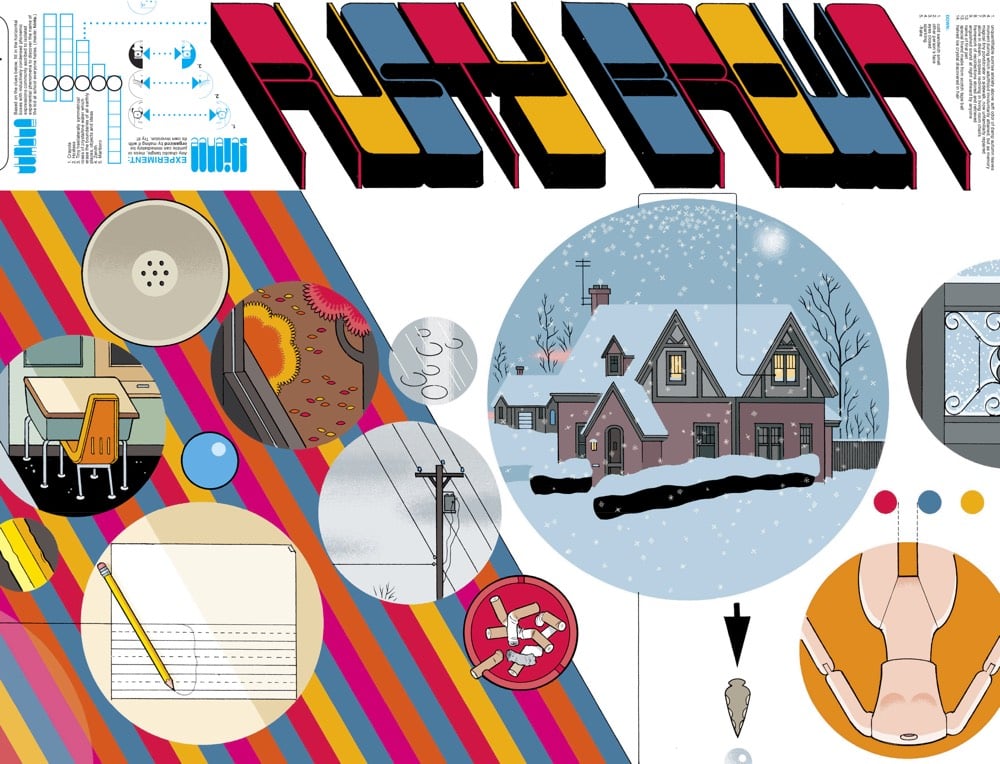
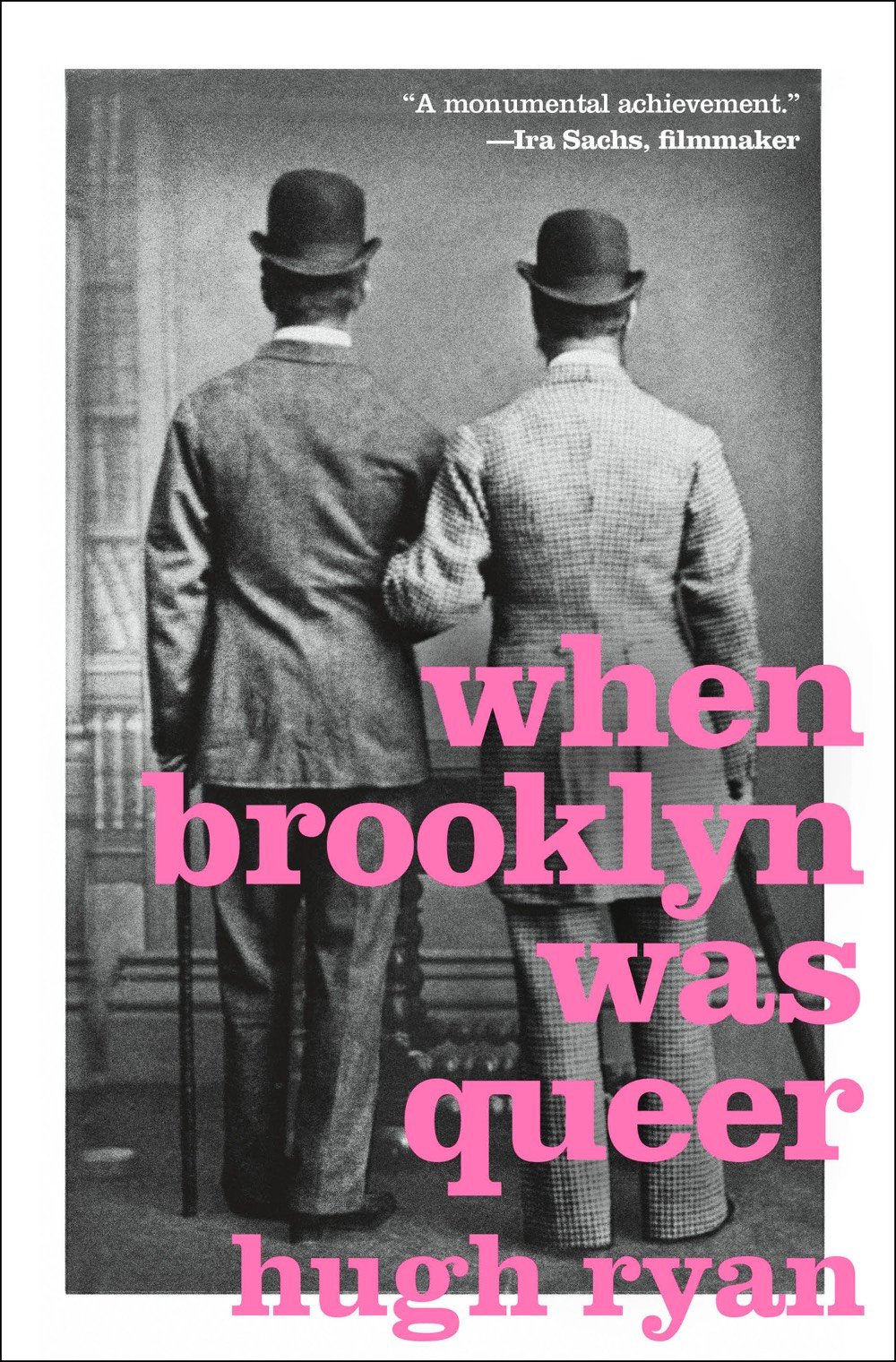



The AIGA has announced the winners of its annual 50 Books / 50 Covers competition for books published in 2019. The competition recognizes excellence in both book design and book cover design — some of the winners placed in both categories. You’ll notice there are not a lot of books here that you’d find on the front table of the bookstore — the winners tend to be from smaller publishers and/or academic in nature and/or about art or design. For lists containing more mainstream books, check out the lists from the NY Times, Buzzfeed, and Lithub.
The books pictured above (from top to bottom) are Rusty Brown by Chris Ware, When Brooklyn Was Queer by Hugh Ryan, Love Drones by Noam Dorr, Signal. Image. Architecture. by John May, and False Bingo by Jac Jemc.
Solving “The Miracle Sudoku”
Every once in a while during my internet travels, I run across something like this video: something impossibly mundane and niche (a ~26-minute video of someone solving a sudoku puzzle) that turns out to be ludicrously entertaining. I cannot improve upon Ben Orlin’s description:
You’re about to spend the next 25 minutes watching a guy solve a Sudoku. Not only that, but it’s going to be the highlight of your day.
The solver himself calls it “a work of sublime genius” and “one of the most extraordinary puzzles we’ve ever seen”. It’s fascinating listening to him slowly uncover different aspects of the puzzle — watching him methodically figure out the 3s was genuinely thrilling. And the symmetry thing at the end…
If you fancy yourself a sudoku master, you can try solving the puzzle yourself here (keeping in mind the special chess-related rules laid out in the video). (via @robinsloan)
A Very Short Guide to Union Glacier Camp in Antarctica
In this charming little film (that feels very Wes Andersonian), we get to visit the Union Glacier Camp in West Antarctica, see what life is like there, and meet the people who run it. The camp is situated next to a blue-ice runway (which makes the area accessible to large aircraft) and serves as the jumping-off point for many kinds of activities, projects, and expeditions.
Union Glacier Camp is the only facility of its kind in Antarctica. Our full-service private camp operates during the Antarctic summer (November through January) and is dismantled at the end of each season. Our camp not only provides accommodations to guests on guided experiences but also serves as a logistics hub, supporting private expeditions and National Antarctic Programs.
I love the grid of tents for guests.
We can house up to 70 guests in our dual occupancy Clam Tents. These double-walled sleeping tents are designed to withstand Antarctic conditions with a high-tech nylon covering and durable aluminum frame that opens up like a clam shell. They are also incredibly comfortable to live in with large doors and a tall interior that allows you to stand upright and move around easily (16 ft x 8 ft or 5 m x 2.4 m). Tents are naturally heated by the 24-hour sunlight up to 60^0-70^0F (15^0-21^0C) but also have a wooden floor underneath to provide insulation from the snow and solid footing. Each guest is provided with a cot, mattress, pillow, linens, towels, and wash basin.
Tourist trips to Union Glacier start at $26,000 for six days.
Da 5 Bloods, a New Spike Lee Joint
Spike Lee’s newest film, Da 5 Bloods, is coming to Netflix on June 12 and the trailer, driven by the Chambers Brothers’ psychedelic rock anthem Time Has Come Today, is really compelling.
From Academy Award(R) Winner Spike Lee comes a New Joint: the story of four African-American Vets — Paul (Delroy Lindo), Otis (Clarke Peters), Eddie (Norm Lewis), and Melvin (Isiah Whitlock, Jr.) — who return to Vietnam. Searching for the remains of their fallen Squad Leader (Chadwick Boseman) and the promise of buried treasure, our heroes, joined by Paul’s concerned son (Jonathan Majors), battle forces of Man and Nature — while confronted by the lasting ravages of The Immorality of The Vietnam War.
Having recently been to Vietnam and done a bit of reading about US veterans retiring there, I’m interested to see how Lee handles that dynamic and portrays the country.
Mount St. Helens erupted 40 years ago today. Here are some photos of the eruption and the aftermath.
We should all be required to wear masks in public. “This evidence seems, to me, clear and simple: COVID-19 is spread by droplets. We can see directly that a piece of cloth blocks those droplets and the virus those droplets contain.”
Meander Maps for Imaginary Rivers
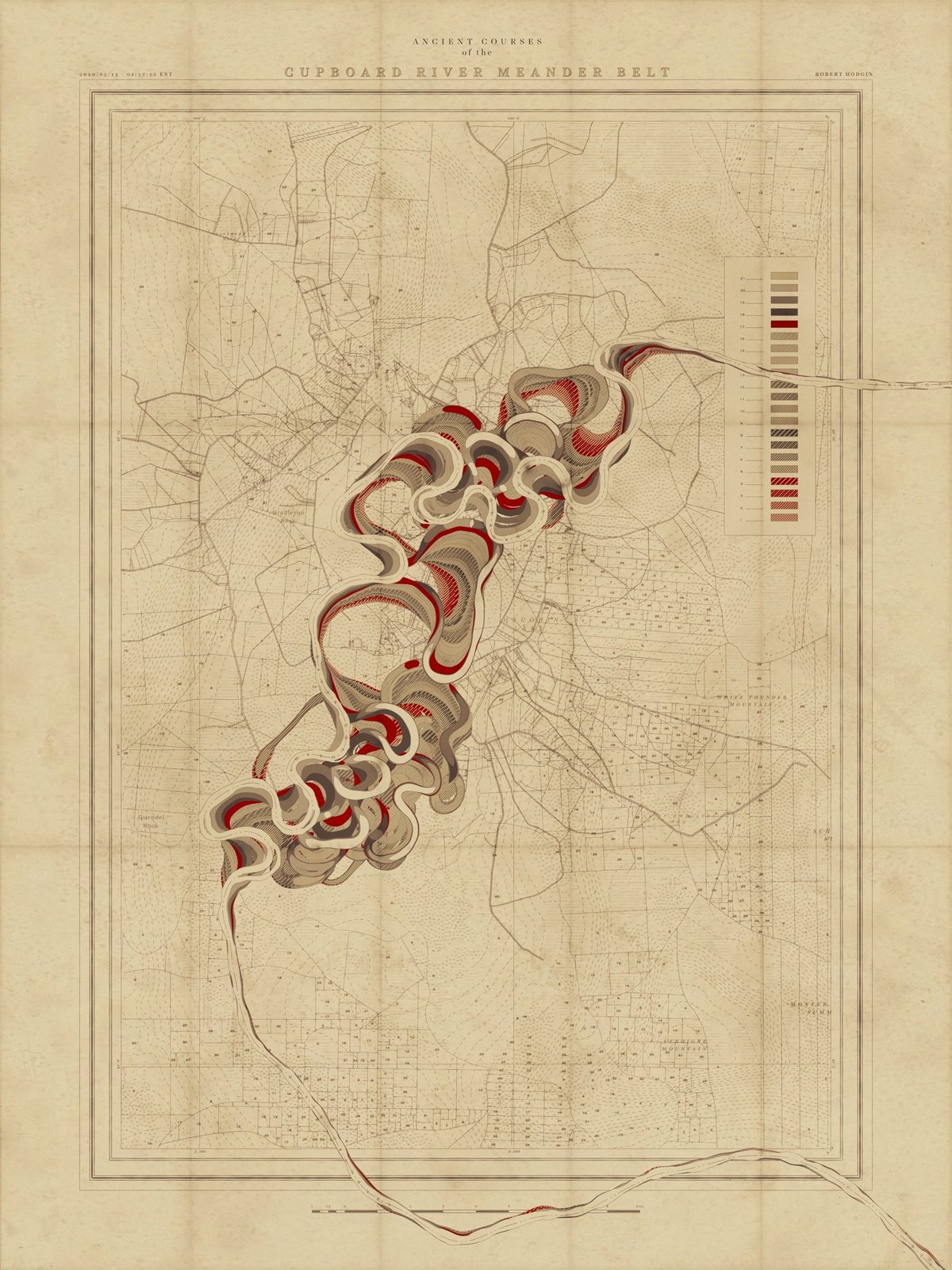
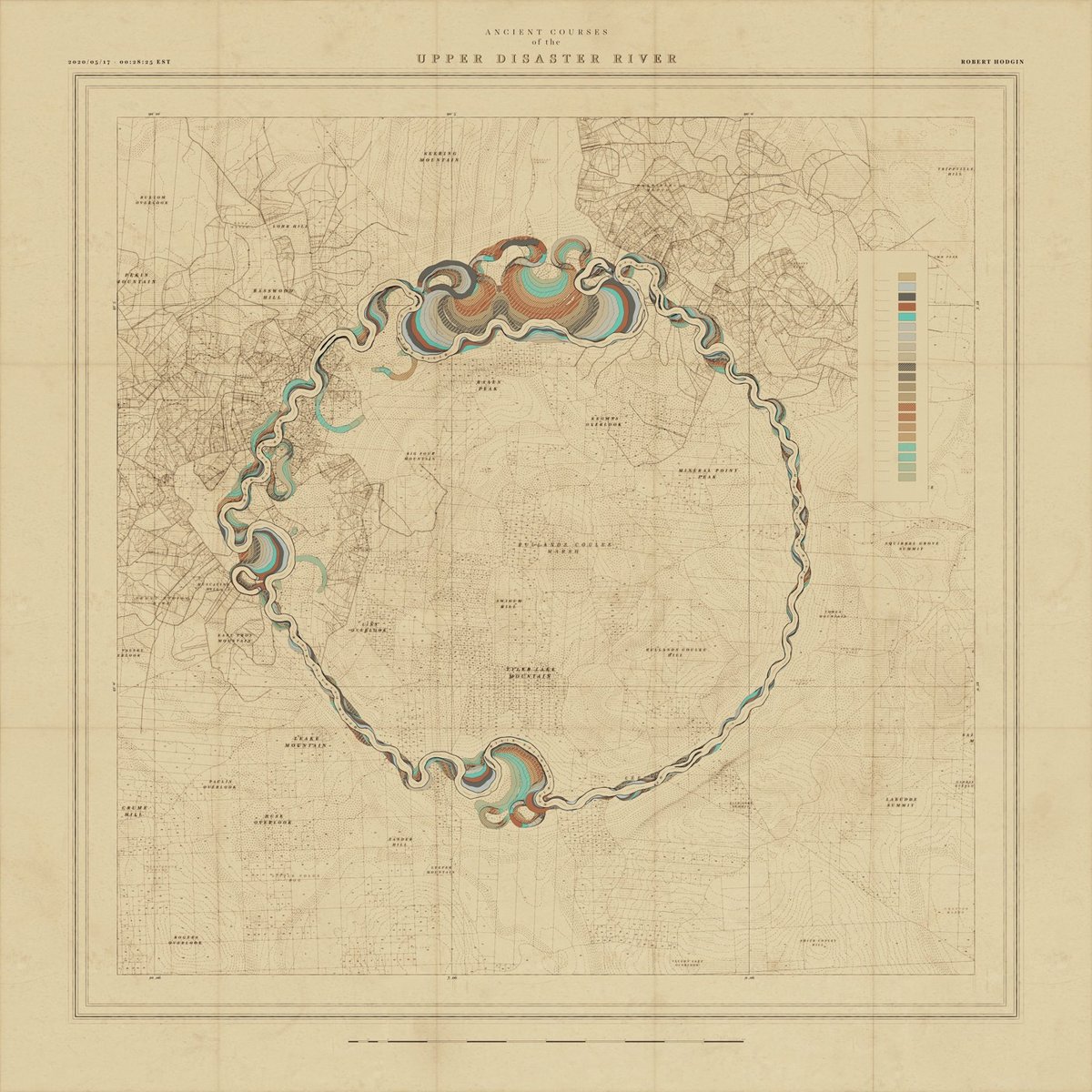
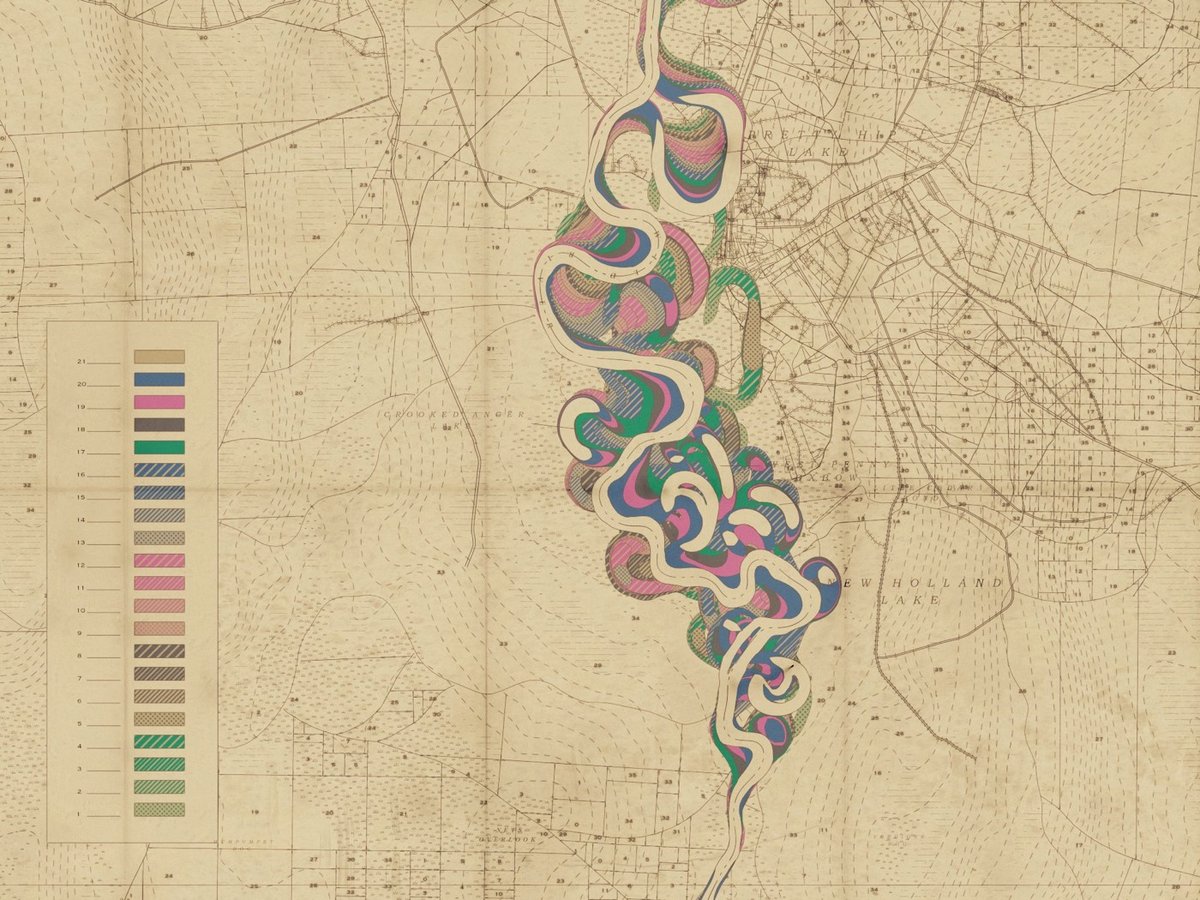
I have written previously about cartographer Harold Fisk’s wonderful meander maps of the Mississippi River produced for the Army Corps of Engineers. Borrowing the aesthetic of these maps, interactive artist & engineer Robert Hodgin wrote some software called Meander to generate meander maps for fictional rivers.
From an input curve, the terrain, land plots, side roads, highways, marsh land and mountain peaks are generated and prominent features are named. The map is then weathered and rendered in the style of old US Army Corp of Engineers maps from the 1930s and 40s.
You can check some of the generated maps out on Twitter or on Instagram, including some prototypes and animations (this one is my favorite). Hodgin has promised a full write-up of the project; I’ll link to it when he publishes it.
Coincidentally, while I was writing this post I got an email from a reader about an audiovisual installation called Meandering River that displayed “real-time visuals generated by an algorithm and music composed by an A.I.”
Synchronicity!
Update: Hodgin wrote about the Meander project on his website and included several more gorgeous examples of his output.
Pizza Arbitrage. “If someone could pay Doordash $16 a pizza, and Doordash would pay his restaurant $24 a pizza, then he should clearly just order pizzas himself via Doordash, all day long. You’d net a clean $8 profit per pizza.”
Here’s How Time Works Now. “A minute can now either be one hour, or it can take 3.5 seconds. We hope you enjoy this new feature.”
Shakespeare in the Park’s Much Ado About Nothing Streaming Online for Free
One of many cancellations due to the pandemic is the Public Theater’s annual Shakespeare in the Park performances. But for the next three weeks, PBS is streaming their Great Performances recording of last year’s Shakespeare in the Park production of Much Ado About Nothing for free on their site (embedded above, reviews here).
This bold interpretation of Shakespeare’s comedic masterpiece features Danielle Brooks (“Orange is the New Black,” Broadway’s “The Color Purple”) and Grantham Coleman (“Buzzer,” “The Americans”) as the sparring lovers Beatrice and Benedick. Tony Award winner Kenny Leon (“American Son,” “A Raisin in the Sun”) directs with choreography by Tony Award nominee Camille A. Brown (“Choir Boy”).
To whet your appetite, you can check out some of the highlights of the performance in this short video.
P.S. You can also watch this 2009 production of Macbeth starring Patrick Stewart in the lead role. (via laura olin)
The latest issue of the @kottke newsletter just went out. Prince, book recs, Covid slang, and more!
Cities Are Meant to Stop Traffic
I recently came across this quote from Kirkpatrick Sale’s 1980 book Human Scale and it succinctly relates a fundamental truth about the purpose of cities.
Cities are meant to stop traffic. That is their point. That is why they are there. That is why traders put outposts there, merchants put shops there, hoteliers erected inns there. That is why factories locate there, why warehouses, assembly plants and distribution centers are established there. That is why people settle and cultural institutions grow there. No one wants to operate in a place that people are just passing through; everyone wants to settle where people will stop, and rest, and look around, and talk, and buy, and share.
Cities, in short, should be an end, not a means. Rationally one wants to have traffic stop there, not go through, one wants movement within it to be slow, not fast.
Sale goes on to list four ways in which cities should think about slowing traffic down:
- Cities should not try to move people to facilities but provide facilities where the people are.
- Cities should be small enough so that inter-community trips, when necessary, could be managed either on foot, by bike, or with some simple subway or trolley system.
- Cities should attempt to slow down the flow of traffic, particularly with plenty of squares and plazas and parks, places where wheeled vehicles are forced to halt, endpoints that invite stopping and resting.
- Cities should try to bring home and workplace back together.
You can read the entire excerpt on Google Books. (via @grescoe)
Update: Some alert readers let me know that Kirkpatrick Sale is a left-wing secessionist, which has brought him and his various organizations into contact & cooperation with racist hate groups and white supremacist organizations. I’m not going to link to it, but he’s written some stuff recently about how the Confederacy and slavery weren’t so bad (with tired arguments like white slave owners treating their slaves well) for an organization dedicated to exploring the “Southern tradition”. The white Southern tradition, mind you — there are no black voices or faces represented on their site as far as I can tell. I will leave it as an exercise for the reader as to whether that changes how you feel about his views on how to fix cities.1 (thx, edward & @paulbeard)
For me, it does. It’s fine to advocate for more bike transportation & workplaces close to home, but cities can accomplish that in a way that takes into account lower income communities (which in American cities are often made up of PoC and immigrants) or not. Everyone who lives in the West Village working close to their house and being able to walk to the store is fine — and perhaps if you’re Sale, you’d say “mission accomplished” — but if the restaurant busboys, teachers, shop clerks, dry cleaners, store owners, plumbers, firefighters, and all the other people that make that neighborhood actually function can’t afford to live anywhere close to the neighborhood and are still spending hours every day commuting on the subway to & from Queens, the Bronx, or Brooklyn, I would argue you really haven’t solved, or even begun to solve, the problem of moving home and workplace closer together.↩
A Virtual Stroll Through Manhattan, Circa 1609

The NY Times’ Michael Kimmelman has been taking a series of virtual walks around NYC, exploring different aspects of the city. His latest walk is with Eric Sanderson, conservation ecologist and author of Mannahatta: A Natural History of New York City. The pair of them start at the southern tip of Manhattan over 400 years ago, with Sanderson explaining how the island would have appeared when Henry Hudson arrived in 1609.
Michael Kimmelman: Aside from Hudson’s ship, what do we see?
Eric W. Sanderson: Whales and porpoises. One of the earliest sketches we have of Manhattan shows a whale in the Hudson River. The charter of Trinity Church includes a provision specifically saying dead whales found on beaches in the province of New York are property of the church, which could use them to make oil and whale bone. So whales were clearly a meaningful part of the local economy and ecosystem.
Kimmelman: What was the ecosystem?
Sanderson: Ecosystems, actually. Manhattan is something like one percent the size of Yellowstone. Yellowstone is 2.2 million acres and it has 66 ecosystems. Mannahatta had 55.
It’s an interesting thought exercise to imagine what might have happened had the United States been colonized from the West, instead of from the East. We might have decided to make Manhattan a national park. We would be coming to New York for an entirely different sort of wildlife.
Questlove is DJing Up a Storm During Quarantine
Most nights since mid-March, The Roots’ Questlove has been doing lengthy DJ sets for fans, kind of like a series of distributed house parties. The shows range in length from 2.5 hours to more than 6 hours — most are in the 3-4 hour range. The past shows have been collected in this playlist. The most recent show, from Tuesday, celebrated the 70th birthday of Stevie Wonder:
He did a 3-hour set made up of audience requests:
And of course there were sets focused on particular artists and bands — the Beastie Boys, James Brown, and Prince:
From a Fast Company piece about how The Roots have adapted their approach to entertainment during the pandemic:
“My whole narrative is that I’m this musical griot or this musical expert with 170,000 pieces of vinyl that you can Google, but now that I’m thrown in the pool, I realized, yeah, I have 170,000 records, but at the end of the day, I know maybe 400.”
Questlove has digital access to about 30% of that massive collection and decided to get to know more of his songs in front of a live audience. It’s different when that audience is the internet, but Questlove gets it now. He can reach more people. He’s having fun with his selections, and his diverse and meticulous approach to music shows up in his nightly playlists.
“I challenged myself to do a dancehall set that didn’t require me to play ‘Murder She Wrote.’ I’m gonna try and do the salsa set that doesn’t require me to play like ‘Suavemente,’ all the Captain Obvious stuff,” he explains. “So, I mean just as a music lover and a musician, it’s challenging me to find exciting ways to present music.”
Chair Times: A History of Seating
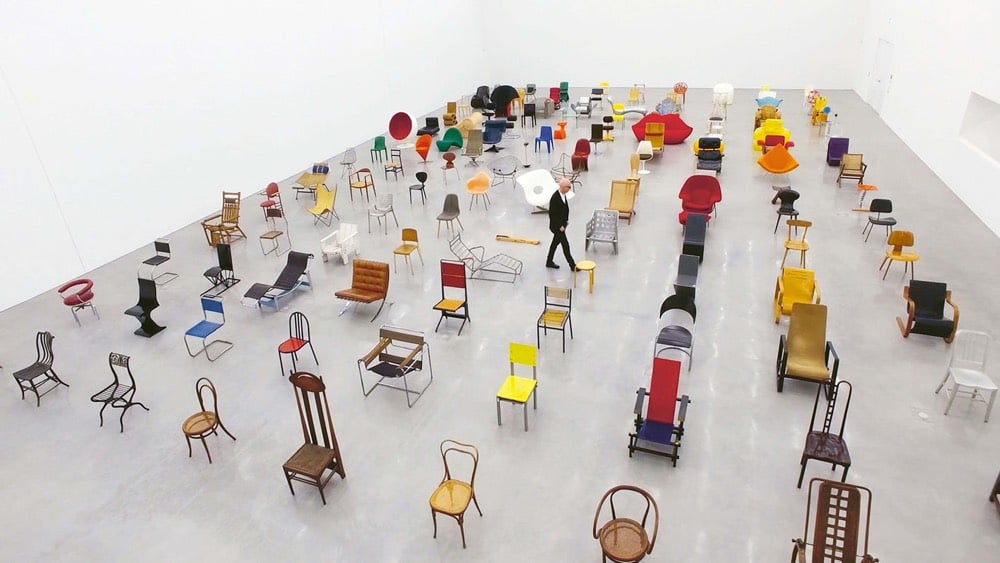
For a limited time, you can view the feature length documentary Chair Times: A History of Seating online for free courtesy of Vitra, a Swiss design company. Here’s a trailer:
In the focus are 125 objects from the Collection of the Vitra Design Museum. Arranged according to their year of production, they illustrate development from 1807 to the very latest designs straight off the 3D printer, forming a timeline to modern seating design.
Accompanying the film is a book of the same name. (via moss & fog)
The Joy of Werner Herzog
I missed this David Marchese interview of Werner Herzog back in March but was happy to run across it today — it is the perfect lunchtime read.
When you pulled Joaquin Phoenix from a car accident, did you know it was him? Yes, although he was upside down in this car, squished between airbags that had deployed and wildly trying to light a cigarette.
That could be an image from one of your films. I knew he must not light his cigarette, because there was gasoline dripping and he would have perished in a fireball. So I tried to be clearly commandeering to him and tell him not to. But I was worried that if you gave him a command, he would strike his lighter even harder. So I managed to snatch the cigarette lighter from his hand. Then it became completely clear that it was Joaquin. But I didn’t want to speak to him after. I saw he wanted to come over and thank me. I just drove off.
Herzog talking about his time making The Mandalorian:
What about baby Yoda? Did you think baby Yoda was cute? No, not cute. It was a phenomenal achievement of sculpting mechanically. When I saw this, it was so convincing, it was so unique. And then the producers talked about, Shouldn’t we have a fallback version with green screen and have it be completely digitally created? I said to them: It would be cowardly. You are the trailblazers. Show the world what you can do.
See also 24 Pieces of Life Advice from Werner Herzog, including “Take revenge if need be” and “Carry bolt cutters everywhere”.
The Winners of the 2020 BigPicture Natural World Photography Competition
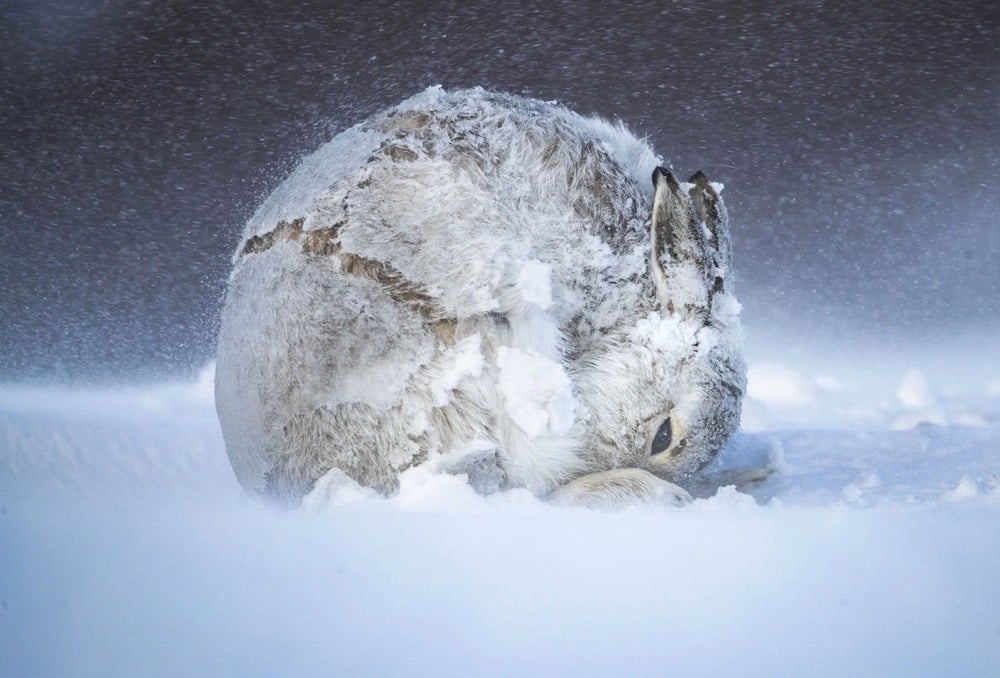

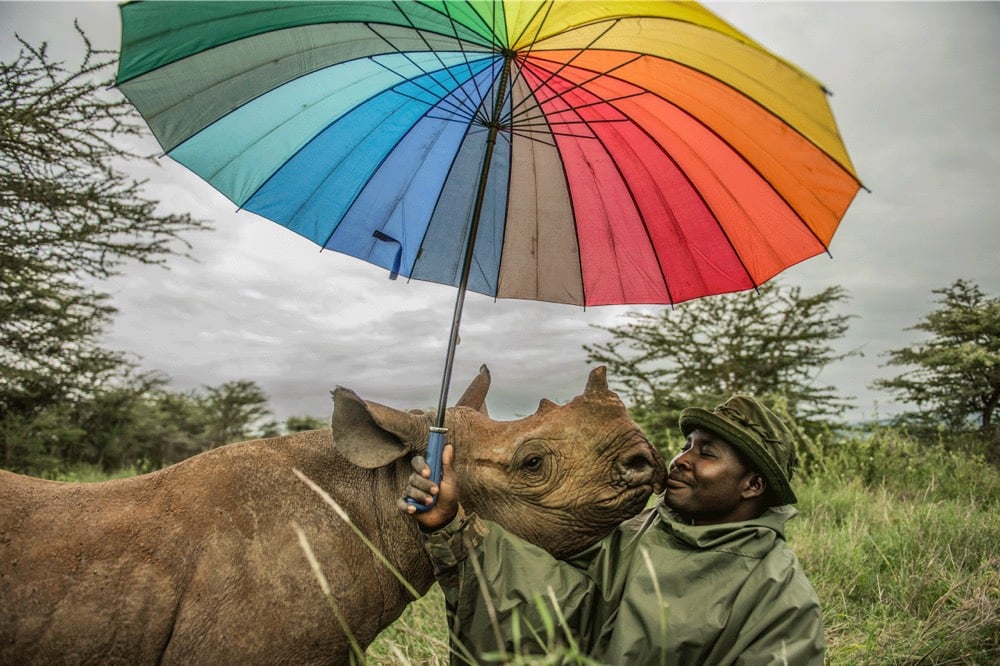
In Focus has a selection of the winners of the 2020 BigPicture Natural World Photography Competition organized by the California Academy of Sciences. Here’s how Andy Parkinson got that amazing photo of the hare:
To get this intimate shot of a mountain hare (Lepus timidus) curled up against a Scottish winter storm, Andy Parkinson endured weeks of ferocious cold and wind that drove shards of ice into his face. Britain’s only native rabbit species, on the other hand, is utterly at home in these inhospitable conditions. Groups of twenty or more hares gather each winter to nibble heather on leeward slopes, where the snow tends to be shallower. Before resting, they jump away from their tracks to confuse predators. And while some ride out storms in burrows or depressions, this female created her own shelter, tucking herself into a ball to conserve heat and minimize exposure to the elements. It’s a nifty strategy for surviving the kind of weather that drives most creatures indoors or underground.
You can view the winners and category finalists on the BigPicture Competition website. Photos above (top to bottom) by Andy Parkinson, Jes Stockhausen, and Amy Vitale.
On March 24, Janice Brown was the first person to test positive for SARS-CoV-2 in her CA town. After recovering, she tested positive for a second time on April 21. “Is it a reinfection or the same infection? We don’t know.”
I really enjoyed this discussion between Ezra Klein and Madeline Miller (author of Circe & Song of Achilles). “When you do get everything you want, when you do have absolutely everything, it doesn’t make you a good person, actually.”
Covid-19 Slang and How Language Evolves Quickly in Stressful Times

Kate Burridge and Howard Manns recently wrote a piece about how the Covid-19 pandemic is changing the English language. It’s written from an Australian perspective, so some of the slang might be a bit hard to follow for Americans et al.
In these times of COVID-19, there are the usual suspects: shortenings like “sanny” (hand sanitizer) and “iso” (isolation), abbreviations like BCV (before corona virus) and WFH (working from home), also compounds “corona moaner” (the whingers) and “zoombombing” (the intrusion into a video conference).
Plenty of nouns have been “verbed” too — the toilet paper/pasta/tinned tomatoes have been “magpied”. Even rhyming slang has made a bit of a comeback with Miley Cyrus lending her name to the virus (already end-clipped to “the Miley”). Some combine more than one process — “the isodesk” (or is that “the isobar”) is where many of us are currently spending our days.
“I’ve got the Miley”…I’ve always been a fan of rhyming slang. Linguist Tony Thorne, who specializes in slang & jargon, has compiled a list of new language introduced to (and by) the general public because of the pandemic.
Quarantimes - a hashtag or label for the prevailing circumstances under lockdown due to the coronavirus pandemic
Rona, Lady Rona, roni, rone - the coronavirus personified/familiarised
Boomer remover - the coronavirus viewed as a phenomenon resulting in the decimation of the baby boomer demographic
Covidiot - a person behaving irresponsibly in conditions of containment
Doomscrolling/doomsurfing - obsessively accessing upsetting news online
Infits - outfits worn in conditions of confinement
Zoom mullet - a hairstyle developed in lockdown which is ‘camera-ready’ (presentable to a webcam) at front and sides and dishevelled at the rear
Covid waltz - manoeuvring to avoid close contact with passers-by while distance restrictions are in place
Apropos Couchella illustration by the awesome Gemma Correll. (via lera boroditsky)
The cast & crew of Back to the Future reunite via video chat, incl. Christopher Lloyd, Michael J. Fox, Lea Thompson, Elizabeth Shue, Huey Lewis, etc.
An Oral History of Mad Max: Fury Road

The endlessly rewatchable Mad Max: Fury Road has become one of my absolute favorite films, so I really enjoyed digging into this oral history of the movie (with contributions from director George Miller, editor Margaret Sixel, Charlize Theron, Tom Hardy, and many others). It is a miracle this thing got made and downright impossible that it was so good.
HARDY: Charlize arguably laid down the finest lead character in an action movie, and that credit is much deserved, in my opinion; both to her as a phenomenal talent and also to George for recognizing from the very start that it was time to pass Mel’s shoes onto Furiosa.
THERON: At first, Furiosa was this very ethereal character, with long hair and some African mud art on her face. It was a different costume designer back then, before Jenny Beavan, and the costume felt a little more Barbarella-y. I worried about it.
JENNY BEAVAN (costume designer): I am not into fashion, and I don’t particularly care what people look like — the clothes have to come out of the stories they tell. Since she travels long distances, Furiosa needed very practical clothing, and when I met with Charlize, that was one of the things we talked about. That, and what on earth would she do with her hair?
THERON: George was really incredible in just hearing me out. I called him and said, “I don’t know how she’s getting by in the mechanics’ room with all this hair. I think we need to shave my head, and she needs to be a more androgynous, grounded character.” You know, he trusted me so much that it kind of makes me emotional. In that sense, I feel like I let him down.
Sixel won an Oscar for her editing of Fury Road:
SIXEL: There was this constant thing from the studio: “How much shorter is it?” That’s all they wanted to know. I just got so sick of it. They were just obsessed with getting the film under 100 minutes, which I knew was impossible.
MILLER: When someone is directing a film, they’re thinking about it every waking hour, and even processing it in their dreams. The problem is, if you’re a studio executive, you tend to think about it for 10 minutes on a Wednesday.
SIXEL: It was an incredibly painful film to cut. I think the studio didn’t believe in it, so it was really difficult to keep going. Eventually George and I decided, “We’re just going to make the film we want to make, and if no one else likes it, that’s fine.” And that last four months is when the film really came together.
And it blew people away and was taken seriously when it came out, which surprised the filmmakers:
MILLER: In Japan, there was a critic who was telling me about the film, and I was astonished by the degree to which he read the subtext, all the stuff you hope is there. I said, “How many times did you see the film?” He said, “Only once. Can I show you something?” And he opened up his shirt, and he had the logo of the Immortan tattooed in red on his chest. So when you see things like that, you’re sort of humbled by it.
(thx, david)
Update: The author of the oral history shared some outtakes on Twitter.
The first time Charlize Theron saw FURY ROAD, it was a 3-and-a half hour cut, and she fell hard for it: “I felt like for the first time in my career, I was part of something where you could truly say, ‘This feels original.’”
And Theron herself posted some photos, videos, and memories of the filming, including this:
I’ll never forget the feeling of seeing my war rig for the first time and realizing holy shit, George is not f*cking around.
She also posted the photo at the top of this post. (via @thatneilguy)
Fascinating & heartbreaking little vignettes from those who are living alone during the pandemic. “I live for the day when I can hold the hands of those I love.”
Prince and the Revolution Live Show from 1985 Will Be Shown on YouTube for a Limited Time
As part of a benefit for Covid-19 relief, The Prince Estate will be broadcasting a classic concert by Prince & the Revolution from 1985’s Purple Rain tour on YouTube. The stream (embedded above) will begin on Thursday, May 14 at 8pm ET and will only be available through Sunday, May 17.
The concert was recorded in Syracuse, NY on March 30, 1985 and is considered a classic, a show that found Prince at the crest of his pop culture stardom. Laurie Gwen Shapiro recounted going to the show in college — a friend of hers camped out in the ticket line to get front row seats.
In the past decade it has been very difficult to find this legendary concert film in the United States that was later released in the 1991 as “Prince and the Revolution Live!” on VHS only. If you watch the film — and I swear this is true — I am the person the cameras flashes on first in a venue that holds 40,000 plus, and I am making a rather ridiculous orgiastic face for the ages. To understand how I was the beneficiary of such dumb luck, and the greatness of Prince’s performance, let’s go back to 1985 when the internet was yet to come.
The setlist includes many of his most popular songs — Let’s Go Crazy, When Doves Cry, 1999, Little Red Corvette — and the show ended with a 20-minute rendition of Purple Rain (10 minutes of which is a Prince guitar solo).
By the time they finished a towering 20 minute rendition of “Purple Rain,” featuring what is probably the best single guitar solo I’ve ever witnessed in the flesh, most of the crowd would have let Prince do anything with them that he wished. What Prince did to us, and for us, was the best gift of all.
The show is also available on DVD as part of this remastered edition of Purple Rain. The remastered audio from the concert will also be released to streaming services on Friday.
Update: The live album is now available on streaming music platforms: Spotify, Apple Music, Amazon, Pandora.
The Purple Rain closer clocks in at 19 minutes 26 seconds.
Update: Prince superfan Anil Dash wrote up some notes about this show.
Finally, we come to Prince’s scorching final guitar coda to “Let’s Go Crazy” where he brings out his entire palette of Guitar Face expressions, from playful smirk to full Mustachioed Telecaster Orgasm.
Flat Earthers Listening to Daft Punk
This made me laugh really hard today:
Gotta be frustrating. ♪ Around the world, around the world, around the world, around the world, around the world, around the world… ♪ (thx, naomi)
Polling Indicates Americans Overwhelmingly Agree on Covid-19 Countermeasures
Recent polling compiled by Randall Munroe indicates that Americans agree on what to do about the Covid-19 pandemic to a greater extent than they “feel positively about kittens” or even “enjoy apple pie”.
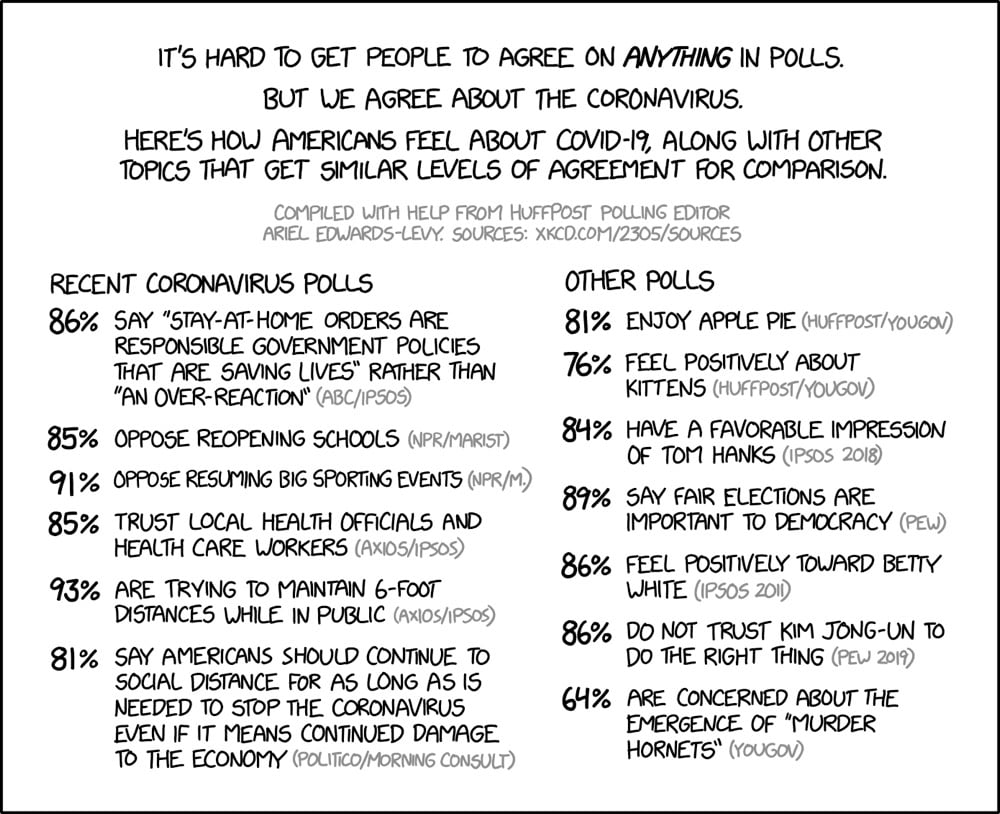
The Simpsons Parody of Succession
In the “couch gag” preceding The Simpsons episode that aired on May 3, 2020, they did a pitch-perfect parody of the opening title sequence of Succession, complete with the iconic theme song. (via @omcfarlane)
The only way to order KFC in Gaza is via an ad hoc Instagram service. “The KFC order will only make it to Gaza after crossing checkpoints supervised by Israel, the Palestinian Authority, and finally, Hamas.”
The Rijksmuseum Has Released a 44.8 Gigapixel Image of Rembrandt’s The Night Watch
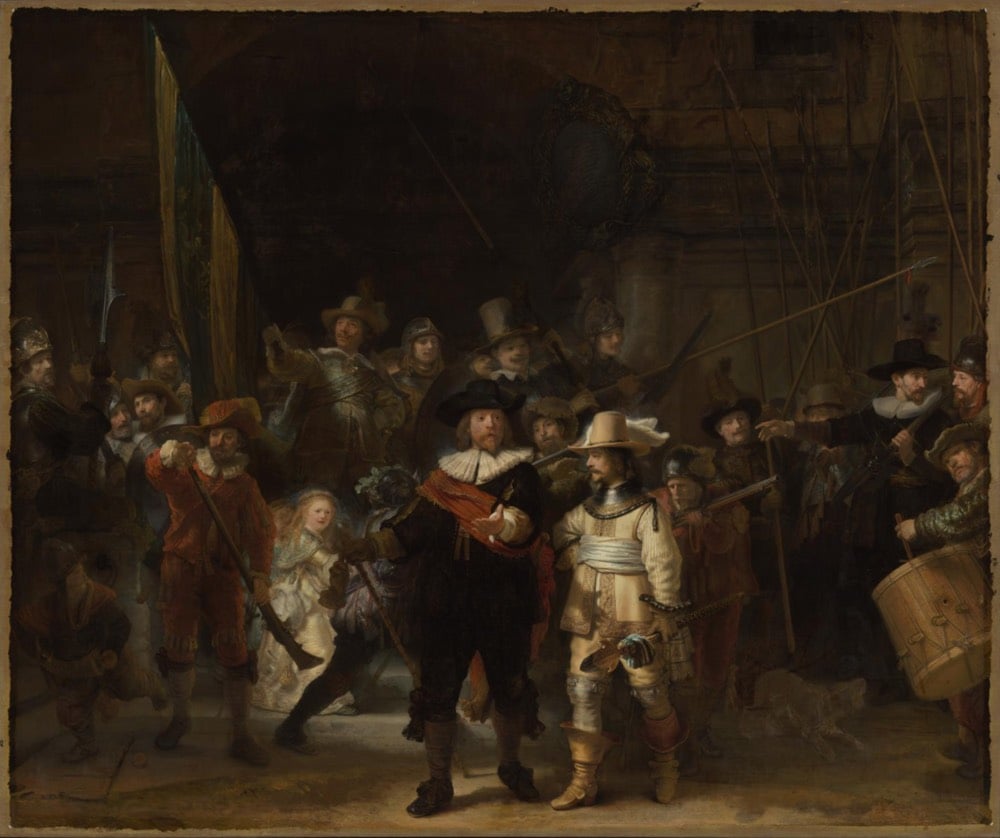
One of Rembrandt van Rijn’s most iconic paintings The Night Watch is currently undergoing restoration at the Rijksmuseum in Amsterdam. As part of the effort, the team took hundreds of photographs of the Dutch master’s painting and stitched them together into a massive 44.8 gigapixel image, which they have released online in a zoomable interface. The level of detail available here is incredible. Here’s the max zoom level on the right eye of the gentleman in the middle, the captain of the company that paid Rembrandt to do the painting:
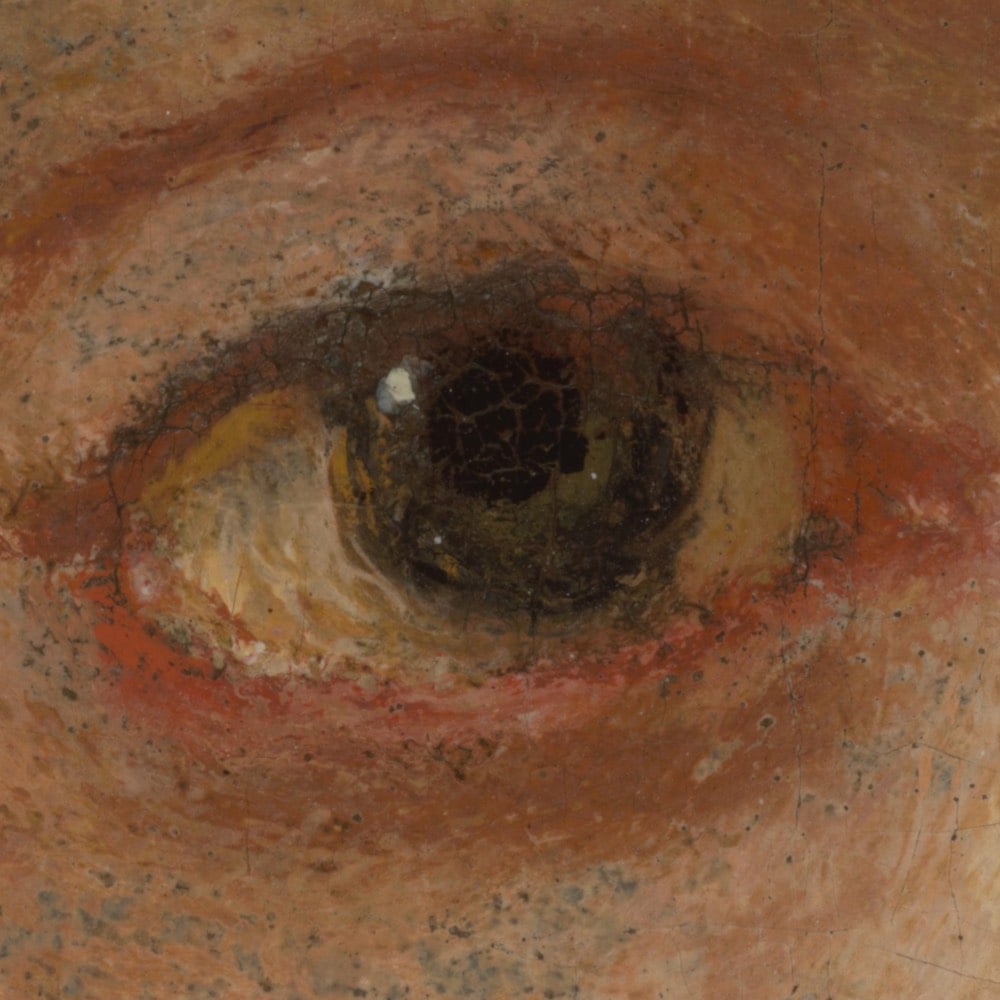
Crazy right? You can see the brushstrokes better than if you were standing in front of the actual painting in the museum.
The Rijksmuseum’s imaging team led by datascientist Robert Erdmann made this photograph of The Night Watch from a total of 528 exposures. The 24 rows of 22 pictures were stitched together digitally with the aid of neural networks. The final image is made up of 44.8 gigapixels (44,804,687,500 pixels), and the distance between each pixel is 20 micrometres (0.02 mm). This enables the scientists to study the painting in detail remotely. The image will also be used to accurately track any future ageing processes taking place in the painting.
Ok, I told you a little fib just now. Actually, this is his eye at the true maximum zoom level:
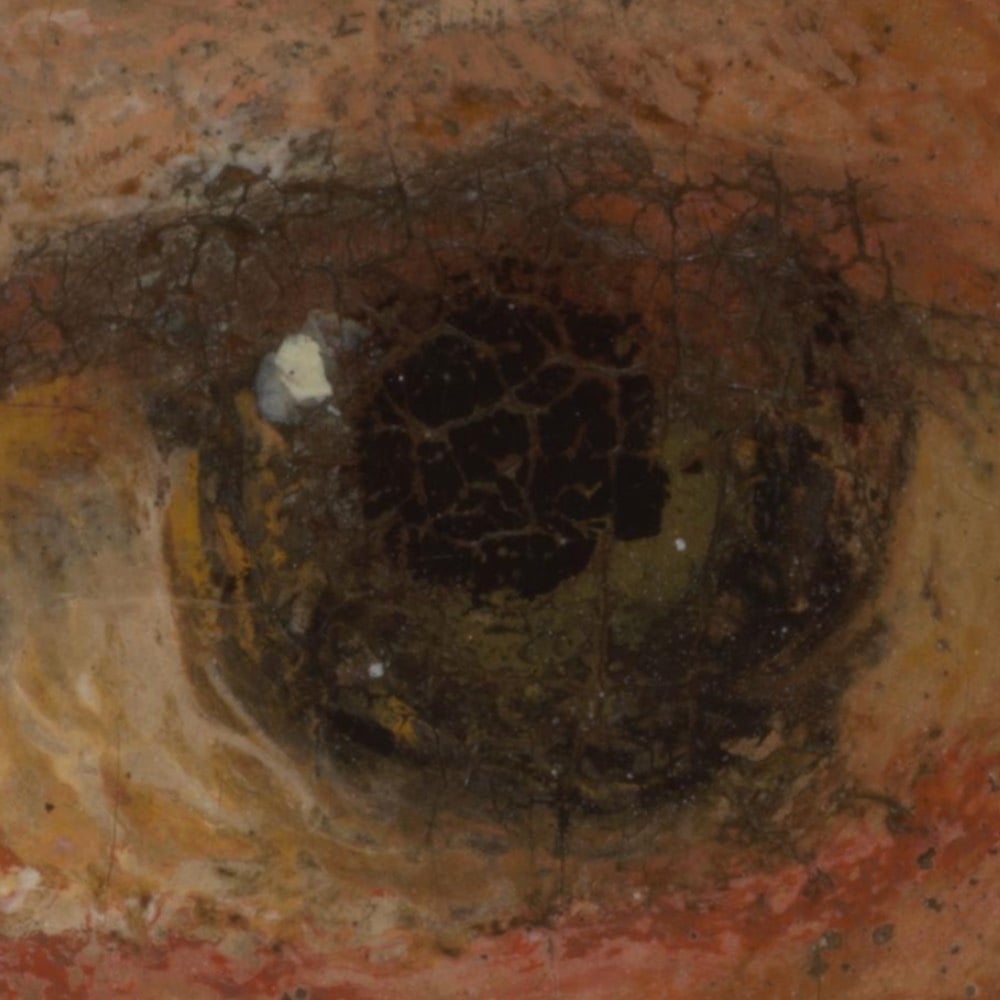
Each pixel is 0.02mm across — and keep in mind that this painting is almost 12 feet high and more than 14 feet across. An astounding level of detail and a gigantic image.
Little Richard quit rock & roll because “a big ball of fire” appeared in the night sky during a concert, which he took as a sign from God. It was actually Sputnik.
11-Year-Old Lands First Ever 1080 on a Skateboard Vert Ramp
11-year-old skateboarder Gui Khury has become the first person ever to land a 1080 on a vert ramp. That’s 3 full spins.
More than two decades after Tony Hawk completed the first 900-degree turn, Khury shattered a long-standing record by flying off the top of a ramp and completing three full spins in the air before landing cleanly and skating off. The manoeuvre has long been one of the holy grails of skateboarding.
“The isolation for the coronavirus helped because he had a life that was about school and he didn’t have a lot of time to train, when he got home from school he was tired,” the skater’s father Ricardo Khury Filho told Reuters.
“So now he is at home more, he eats better and he has more time to train and can focus more on the training so that has helped. He has an opportunity to train here, if he didn’t have [the skate facilities] … he would be stuck at home like everyone else and unable to do sport. So the isolation helped him focus.”
Wow.
Update: Now 12, Khury landed a 1080 at the X Games yesterday and collected a gold medal for best trick. Better yet, he did it in front of Tony Hawk.
Director David Lynch is doing a daily weather report on YouTube. “Here in LA, we’ve got clouds and kinda foggy weather with some blue shining through, 62 degrees Fahrenheit…”
The Real Lord of the Flies
For his new book, Humankind: A Hopeful History, Rutger Bregman uncovered the real-life story of 6 schoolboys who were stranded on a Pacific island for 15 months in 1965-66. What he learned was not the familiar tale of savagery & death told in William Golding’s novel Lord of the Flies. Instead, the boys cooperated and thrived.
But “by the time we arrived,” Captain Warner wrote in his memoirs, “the boys had set up a small commune with food garden, hollowed-out tree trunks to store rainwater, a gymnasium with curious weights, a badminton court, chicken pens and a permanent fire, all from handiwork, an old knife blade and much determination.” While the boys in Lord of the Flies come to blows over the fire, those in this real-life version tended their flame so it never went out, for more than a year.
On Twitter, Bregman shared how he came to learn about this story:
As a proper investigative journalist, I started Googling. Search terms: ‘Kids shipwrecked’. ‘Real-life Lord of the Flies’ etc. After a while, I came across a blog that told this story.
Wow, I thought. If this really happened, then why isn’t it a super famous story? The article did not provide sources. After a couple of hours, I discovered that it came from a book by the anarchist Colin Ward from 1988. He cited an Italian politician Susanna Agnelli.
From a second-hand bookshop in the UK, I ordered her 1986 book, got it two weeks later, and found the story on page 94. But again: same details, same wording, no source. At that point I started to think that it probably didn’t happen.
Here’s a photo of the six boys with Peter Warner, the sea captain who rescued them:
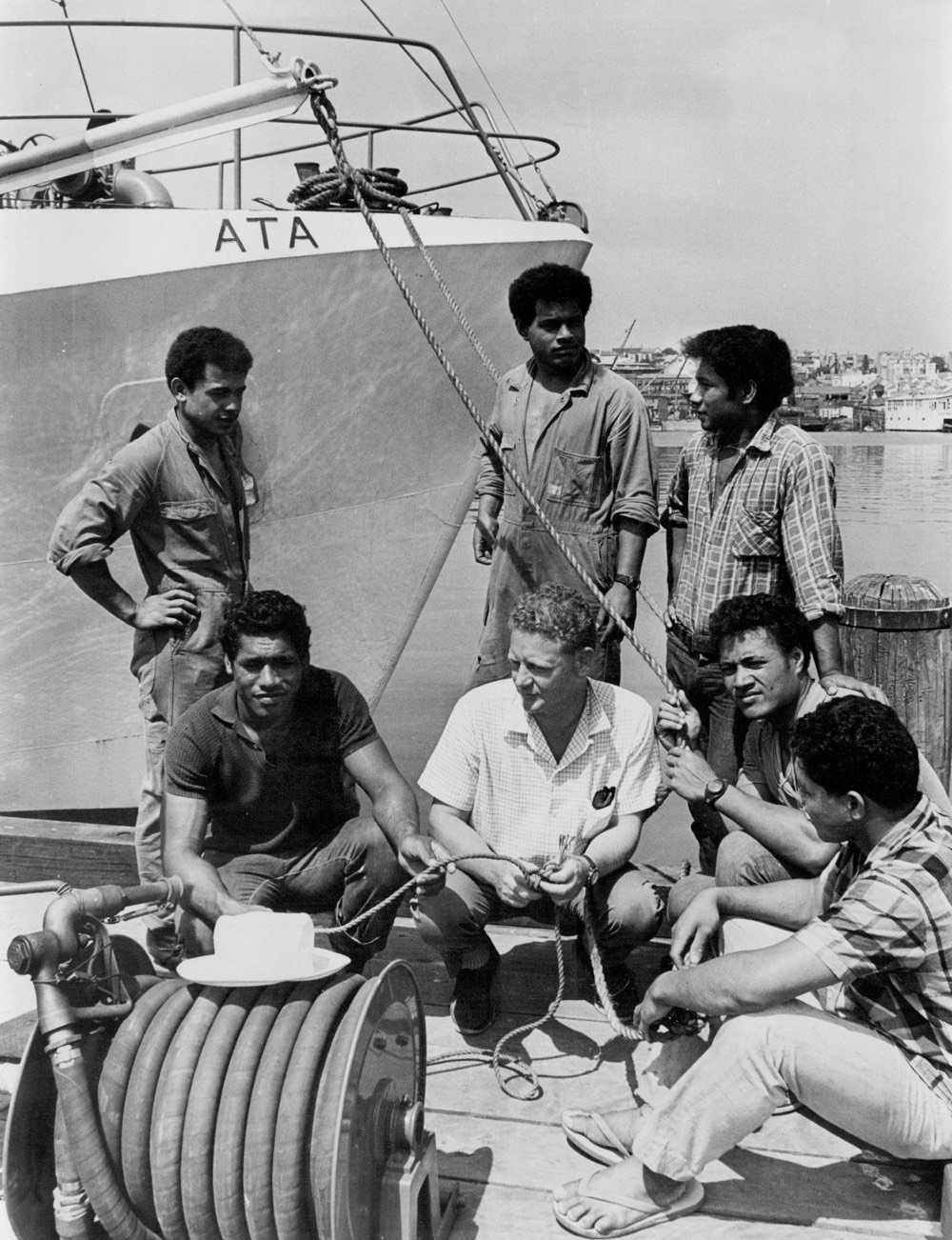
After the rescue, Warner hired the boys as crew members and they worked with him for years. you can read more about Bregman and his new book in this related article.
Update: You may have noticed that Bregman’s piece is told from the perspective of the discoverer of a good story and the sea captain who rescued the boys, and there’s actually relatively little from the boys themselves. Tongan writer Meleika Gesa-Fatafehi wrote a pair of threads on Twitter about how problematic it is that a story about six indigenous schoolboys became one about two white men. First of all, the story was not unknown or forgotten:
I’ve been told many stories about (both) my people getting lost by sea and being stuck on either a boat or Island. But I remember this one significantly because the boys were stuck on ‘Ata. I remember it being called the rock Island.
The local culture that the boys grew up in is essential to the story, particularly w/r/t the lesson Bregman wants to assign to it:
Tongans are taught to share from the beginning. You’re also taught to treat everyone like family. You’re taught to survive together not “Everyman to himself”. It’s hard to exist without community. So when one person is ill or hurt, it’s an automatic reaction to help
To heal and to use knowledge passed down to you. This is seen in every aspect of how the boys survived. They created a community, a small family and worked together.
The white boys of LotF cannot relate because of the very fact they are rich white school boys who aren’t from an Island nation.
LotF isn’t what would happen amongst Tongans because of the value system we have. This is true for every Island nation.
Filmmaker Taika Waititi had this to say about a possible film adaptation:
Personally, I think you should prioritize Polynesian (Tongan if possible!) filmmakers as to avoid cultural appropriation, misrepresentation, and to keep the Pasifika voice authentic.
(via @tinakittelty)
Bypassing a theatrical release, the video recording of Lin Manuel-Miranda’s Hamilton is coming to Disney+ on July 3. “The 2 hour, 40 minute movie was shot two weeks before the original cast left.”
The United States of Voronoi
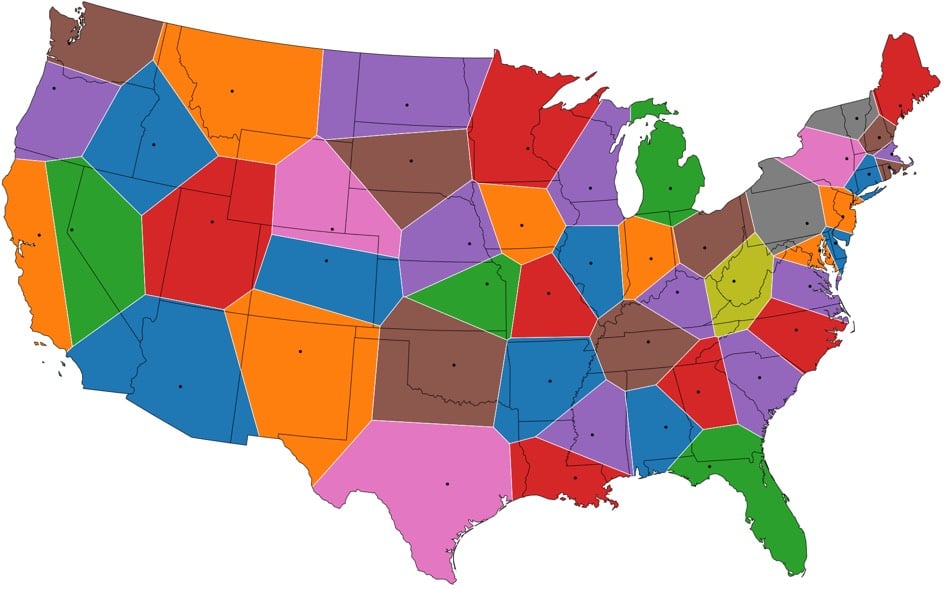
From Jason Davies, this is a US map where the state borders have been redrawn so that all points closest to a state capital than to any other form a state a la Voronoi diagrams. See also Voronoi maps of world airports and world capitals.
It’s interesting that many of the states’ new shapes are similar to their current ones, suggesting that the placement of the capitals relative to borders was somewhat naturally Voronoi-esque, like how people naturally space themselves in elevators or parks.
“The Coronavirus Was an Emergency Until Trump Found Out Who Was Dying”
There are a lot of different lenses you can use to look at how the United States and its government have confronted the Covid-19 pandemic. Race is a particularly useful one. As a reminder, here’s America’s current operating racial contract (from an Atlantic piece by Adam Serwer):
The implied terms of the racial contract are visible everywhere for those willing to see them. A 12-year-old with a toy gun is a dangerous threat who must be met with lethal force; armed militias drawing beads on federal agents are heroes of liberty. Struggling white farmers in Iowa taking billions in federal assistance are hardworking Americans down on their luck; struggling single parents in cities using food stamps are welfare queens. Black Americans struggling in the cocaine epidemic are a “bio-underclass” created by a pathological culture; white Americans struggling with opioid addiction are a national tragedy. Poor European immigrants who flocked to an America with virtually no immigration restrictions came “the right way”; poor Central American immigrants evading a baroque and unforgiving system are gang members and terrorists.
Serwer goes on to argue that the recently shifting American response to the pandemic, primarily in conservative circles, is due to an increasing awareness of which groups are bearing the brunt of the crisis: black and Latino Americans.
That more and more Americans were dying was less important than who was dying.
The disease is now “infecting people who cannot afford to miss work or telecommute-grocery store employees, delivery drivers and construction workers,” The Washington Post reported. Air travel has largely shut down, and many of the new clusters are in nursing homes, jails and prisons, and factories tied to essential industries. Containing the outbreak was no longer a question of social responsibility, but of personal responsibility. From the White House podium, Surgeon General Jerome Adams told “communities of color” that “we need you to step up and help stop the spread.”
This is a response that America is quite comfortable with because it fits with our racial contract, under which Jim Crow never actually ended. The US isn’t the only place this is happening btw. Early on, Singapore was praised for its response to the pandemic, but their reliance on and mistreatment of an underclass of migrant workers caused a secondary surge in cases.
Singapore is a small city-state with a population of just under 6 million inhabitants. On a per capita basis, it’s the second-richest country in Asia.
But its economy relies heavily on young men from Bangladesh, India and other countries who work jobs in construction and manufacturing. Singapore has no minimum wage for foreign or domestic employees. The foreign workers’ salaries can be as low as US$250 per month, but a typical salary is $500 to $600 a month.
The 4-Second Workout!
Recent research has 4-hour workweeked the 7-minute workout and the NY Times is on it!
Four seconds of high-intensity exertion repeated periodically throughout the day might counteract some of the unhealthy metabolic consequences of sitting for hours, according to a surprising and timely new study of the potentially large benefits of diminutive workouts.
The study relied on a specialized type of stationary bicycle that few of us will have available at home, but its implications remain broadly applicable and suggest that even a few minutes - or seconds - of exercise each day could help substantially to bolster our health.
See also greasing the groove:
One way to grease the groove is to just do the exercise whenever you think of it. Ben Greenfield, in Beyond Training, describes how he would do three to five pull-ups every time he walked under a pull-up bar installed in his office doorway. By the end of the day, he’d have performed 30 to 50 pull-ups with minimal effort.
Using a standing desk (featured here in sit-down mode) has made getting short bursts of regular exercise much easier.
I work from home and sprinkle exercise throughout my day. Working at a standing desk makes it easy to walk away from the screen, do a few pull-ups, plank for a minute, do some jumping jacks, and then get right back into whatever I was doing.
I stopped in the middle of writing this post to do some bodyweight exercises on my pull-up bar for about a minute and now I’m back at it — it didn’t even feel like an interruption because I never really lost my train of thought. Now, where’s the 4-millisecond PhD? (via moss & fog)
Virologist Peter Piot, one of the co-discoverers of the Ebola virus, came down with Covid-19 and had to be hospitalized. “Now that I have felt the compelling presence of a virus in my body myself, I look at viruses differently.”
A Practical Guide to Covid-19 Risks and How to Avoid Them
As some places in the United States and other countries are opening back up (some very prematurely), immunologist and biologist Dr. Erin Bromage has written a practical guide to the known Covid-19 risks and how to avoid them that’s based on recent scientific research. He begins:
It seems many people are breathing some relief, and I’m not sure why. An epidemic curve has a relatively predictable upslope and once the peak is reached, the back slope can also be predicted. We have robust data from the outbreaks in China and Italy, that shows the backside of the mortality curve declines slowly, with deaths persisting for months. Assuming we have just crested in deaths at 70k, it is possible that we lose another 70,000 people over the next 6 weeks as we come off that peak. That’s what’s going to happen with a lockdown.
As states reopen, and we give the virus more fuel, all bets are off. I understand the reasons for reopening the economy, but I’ve said before, if you don’t solve the biology, the economy won’t recover.
But since things are opening up anyway (whether epidemiologists like it or not), Bromage goes through a number of scenarios you might potentially find yourself in over the next few months and what the associated risks might be. His guiding principle is that infection is caused by exposure to the virus over time — increase the time or the exposure and your risk goes up. For example, public bathrooms might give you a ton of exposure to the virus over a relatively short period of time:
Bathrooms have a lot of high touch surfaces, door handles, faucets, stall doors. So fomite transfer risk in this environment can be high. We still do not know whether a person releases infectious material in feces or just fragmented virus, but we do know that toilet flushing does aerosolize many droplets. Treat public bathrooms with extra caution (surface and air), until we know more about the risk.
But being in the same room with another person simply breathing may not carry a large risk if you limit the time.
A single breath releases 50-5000 droplets. Most of these droplets are low velocity and fall to the ground quickly. There are even fewer droplets released through nose-breathing. Importantly, due to the lack of exhalation force with a breath, viral particles from the lower respiratory areas are not expelled.
But that time would drop sharply if the person is speaking:
Speaking increases the release of respiratory droplets about 10 fold; ~200 copies of virus per minute. Again, assuming every virus is inhaled, it would take ~5 minutes of speaking face-to-face to receive the required dose.
Again, this is all indoors. Being in enclosed spaces with other humans, particularly if they are poorly ventilated, is going to hold higher risks for the foreseeable future.
The reason to highlight these different outbreaks is to show you the commonality of outbreaks of COVID-19. All these infection events were indoors, with people closely-spaced, with lots of talking, singing, or yelling. The main sources for infection are home, workplace, public transport, social gatherings, and restaurants. This accounts for 90% of all transmission events. In contrast, outbreaks spread from shopping appear to be responsible for a small percentage of traced infections. (Ref)
Importantly, of the countries performing contact tracing properly, only a single outbreak has been reported from an outdoor environment (less than 0.3% of traced infections). (ref)
The Michael Pollan version of advice for socializing during the pandemic might be: Spend time with people, not too much, mostly masked and outdoors.
An interesting thread about the extensive measures taken by South Korea to stem the spread of Covid-19. In America, we’d rather let hundreds of thousands of people die than submit to something so inconvenient.
Trains Speed Through the Swiss Countryside to Techno Beats
Perhaps my fondness for Michel Gondry’s video for The Chemical Brothers’ Star Guitar has primed me to enjoy these POV Swiss train videos paired with techno music. The driving beat of the music, the forward motion of the train, and the soaring scenery complement each other perfectly. (via why is this interesting?)
There is only one known strain of SARS-CoV-2. The term strain is “reserved only for special changes that confer a new property to the virus”.
Pandemic Creativity: Edible Versions of Famous Artworks



In yet another example of how the constraints of the pandemic are fostering creativity, LA-based artist Claire Salvo is creating edible versions of notable artworks and posting the results to Instagram. Says Salvo of her new pursuit:
i make art using a bunch of media, but one sleepless night a few weeks ago, i thought i’d try playing with food. these pieces make me laugh while i’m creating them, and i’m really enjoying the response from everyone watching the process. thanks for all the kind feedback.
i’ve spent nearly 30 years honing my drawing skills, and approximately 1 week pushing banana peels and lentils around a canvas. but i’m learning to #trusttheprocess because #art.
I think the Dali portrait is my favorite, closely followed by the Lichtenstein. And you know I love this: Girl with a Pea Earring.
See also Famous Art Recreated at Home During the Pandemic. (via jenni leder)
The experience of air travel has long been terrible and the pandemic has made it worse. “At the food court, a shouting match broke out among several stressed-out strangers, and police had to intervene.”
Scunthorpe Sans is a font that automatically censors bad language. “Modern fonts can combine letters into a single ligature, usually for things like fi or fl but you can pick anything so we’ve done it for swears.”
Andy Serkis Is Reading The Hobbit Aloud for 12 Straight Hours
Andy Serkis, who played Gollum in the Lord of the Rings movies, is reading The Hobbit (the entire book!) aloud for 12 straight hours today to raise money for Covid-19 relief.
So many of us are struggling in isolation during the lockdown. While times are tough, I want to take you on one of the greatest fantasy adventures ever written, a 12 hour armchair marathon across Middle Earth whilst raising money for two amazing charities which are doing extraordinary work right now to help those most in need in the UK: Best Beginnings and NHS Charities Together.
He’s been going since 5am EST, so you can join in progress or rewind your way back to the beginning. The campaign has already reached its initial goal of £100,000 — you can contribute here. A “special surprise” was promised if the goal was met…I wonder if Ian McKellen or Martin Freeman will be stopping by for a chapter or two?
Music for Empty Malls
Listening to recorded music as if it’s being played in empty malls1 is a thing that I find incredibly soothing and nostalgic and also a little creepy?
An entire playlist is available here. Some of these sound more convincing than others, but almost any of them with 80s music instantly transports me back to wandering past Kay Bee Toys, Chess King, and Spencer’s while wearing my Hypercolor t-shirt, KangaROOS, and Guess jeans.1 (via @Remember_Sarah)
A la running Christian choral music through digital filters to make it sound like it was sung in the Hagia Sophia mosque in Istanbul.↩
Just kidding on the Guess jeans…my family couldn’t afford those! They were like $60! Even Levi’s were a luxury good. I wore mostly Lee or Bugle Boy jeans from Farm & Fleet. The Hypercolor shirt was a Christmas present.↩
On the Accuracy of Covid-19 Testing
As someone who suspects I may have had a mild case of Covid-19 a couple of months ago, I’ve been thinking about getting tested for antibodies. But as this video from ProPublica shows, even really accurate tests may not actually tell you all that much.
And the thing is, the “do I have Covid-19 right now” tests are plagued by the same issue.
For patients getting tested, the main concern is how to interpret the outcome: If I test negative with an RT-PCR genetic test, what are the chances I actually have the virus? Or if I test positive with an antibody test, does it actually mean I have the antibodies?
It turns out that the answers to these questions don’t just hinge on the accuracy of the test. “Mathematically, the way that works out, that actually depends on how many people in your area have Covid,” Eleanor Murray, an assistant professor of epidemiology at the Boston University School of Public Health, said.
The rarer the disease in the population, the less you’ll learn by testing.
Let’s say we have a hypothetical Covid-19 test for antibodies that is both 99 percent sensitive — meaning almost all people with antibodies will test positive — and 99 percent specific, meaning almost all people who were never infected will yield a negative result.
If you test a group of 100 uninfected people, odds are one of them will still test positive even though they don’t have the virus. Conversely, if you test 100 people who were infected, it’s likely one of them will still test negative.
Now let’s presume the virus has a prevalence rate of 1 percent, so one person in 100 carries antibodies to it. If you test 100 random people and get a positive result, what is the chance that this person was truly infected?
Deborah Birx, the White House Covid-19 response coordinator, explained the answer at a press conference on April 20: “So if you have 1 percent of your population infected and you have a test that’s only 99 percent specific, that means that when you find a positive, 50 percent of the time will be a real positive and 50 percent of the time it won’t be.”
So even if I test positive for antibodies and I assume that confers immunity, given that the number of confirmed infections in Vermont is so low (~900 statewide), it doesn’t seem like I would be justified in changing my behavior at all. I would still have to act as though I’ve never had the virus, both for my own health and the health of those around me. Maybe if I had two or three corroborating tests could I be more certain…
Copy & Paste Your Surroundings into Photoshop with a Magical AR App
Designer Cyril Diagne has developed a prototype of an augmented reality app that can copy objects from the real world and paste them into a Photoshop document. Here’s how it works: you point your phone at a book sitting on your desk, the software produces an image of just the book on your phone screen, you point the phone at your computer, and the book image gets pasted into the Photoshop document. It looks like straight-up magic (or at least like a scene from Minority Report or something):
Diagne wrote a thread on Twitter with more technical details. The code is available on Github if you’d like to give it a try. (via colossal)
To deal with the stress, anxiety, and boredom of the pandemic, some are turning to cannabis. “Smoking cannabis has helped people stay inside for generations!”
Radiohead’s Rejected Spectre Theme Song Played Over the Film’s Opening Credits
My kids have been making their way through the Daniel Craig Bond movies so when I mentioned that our local theater was planning on showing drive-in movies on a screen in the parking lot, my son said, “ooh, maybe they’ll show the new Bond movie”.1 Then they began to speculate who would be singing the theme song in the new movie, and I piped in: it’s Billie Eilish and they’ve already released the song.
So we listened to it and, since they had just watched Spectre, I also played Radiohead’s rejected theme song, which I obviously prefer to Sam Smith’s bland Oscar-winning song. This morning, while trying to figure out who sang the official one, I ran across the video of Radiohead’s version played over the opening credits (embedded above). Gah, so much better. What a missed opportunity.
P.S. Funny story from my research: not only was Smith unaware that Radiohead had been asked to do the theme song before them, they were also apparently unaware of who Radiohead frontman Thom Yorke even was.
We’ll have to wait until at least November for that, although I suspect that as the summer goes on and people don’t go back to movie theaters even if they reopen, the studios will have to start releasing films straight to digital/Blu-ray. The can’t delay everything for a year or two.↩
Hiking the Pacific Crest Trail in Three Minutes
The Pacific Crest Trail runs 2650 miles from the border of Mexico to the border of Canada through California, Oregon, and Washington. Hiking the whole thing usually takes months, but this video by Mac of Halfway Anywhere compresses the entire experience down to just three minutes presented in 1-second snippets.
I was skeptical about this going in — I thought it was going to be like watching one of those impossible-to-follow “my life in one-second increments” videos — but the consistent presence of the path tied all the disparate moments into a cohesive journey. You can check out a much longer cut of the same journey and a similar edit of the Continental Divide Trail in four minutes.
The scenery in both of these videos are spectacular and remind me of my roadtrips from the past two years. (via @stewartbrand)
Tips From Someone With Nearly 50 Years Of Social Distancing Experience. “1. Keep track of something. 2. Keep a routine.”
Becoming, a Film About Michelle Obama
Based on her memoir of the same name and produced by the production company she created with her husband, Becoming is a film about Michelle Obama that premiered on Netflix today.
Becoming is an intimate look into the life of former First Lady Michelle Obama during a moment of profound change, not only for her personally but for the country she and her husband served over eight impactful years in the White House. The film offers a rare and up-close look at her life, taking viewers behind the scenes as she embarks on a 34-city tour that highlights the power of community to bridge our divides and the spirit of connection that comes when we openly and honestly share our stories.
The trailer and a clip from the film are embedded above. The clip features Obama talking with a group of young black women on her book tour and one of them asks about getting her life “back on track” after her husband’s presidency. Obama’s answer is remarkably timely:
What I’ve learned is that…get back on what track? It’s a whole new track. It’s not going back — it’s just all different and it’s different forever. So it’s not getting back on track, it’s creating my next track.
I think many Americans and people across the world are struggling with accepting that idea in the midst of the pandemic.
The heavy price of the American brand of freedom & liberty. “This country seems resigned to preventable firearm deaths. It appears that the same is starting to happen with fatalities from the pandemic.”
SARS-CoV-2, An Emerging Portrait
From Nature’s David Cyranoski, a piece that takes a look at what the latest research says about SARS-CoV-2, where it came from, and how it is able to infect the human body. I’m going to highlight a few things from the article I thought were particularly interesting. As Cyranoski has done throughout, I’d like to stress that because this virus is so new to us and the situation is moving so quickly, many of these results are based on preliminary research, have been published in pre-print papers, and haven’t been peer-reviewed.
The first is about the detective work being done to trace where SARS-CoV-2 came from and how long it’s been in existence (possibly decades).
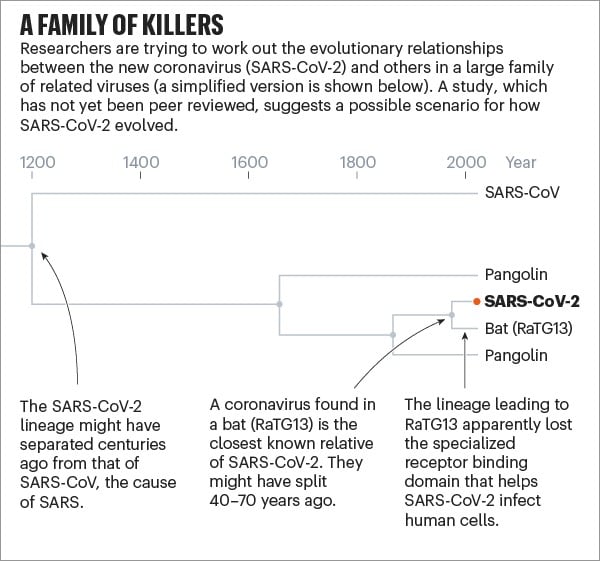
But studies released over the past few months, which have yet to be peer-reviewed, suggest that SARS-CoV-2 — or a very similar ancestor — has been hiding in some animal for decades. According to a paper posted online in March, the coronavirus lineage leading to SARS-CoV-2 split more than 140 years ago from the closely related one seen today in pangolins. Then, sometime in the past 40-70 years, the ancestors of SARS-CoV-2 separated from the bat version, which subsequently lost the effective receptor binding domain that was present in its ancestors (and remains in SARS-CoV-2). A study published on 21 April came up with very similar findings using a different dating method.
The section on how the virus acts in the body is particularly interesting because it attempts to explain the unusual and varying behaviors SARS-CoV-2 exhibits and causes in different parts of the human body. For example, SARS-CoV-2, unusually, can initially infect two places in the body: the throat and lungs.
Having these two infection points means that SARS-CoV-2 can mix the transmissibility of the common cold coronaviruses with the lethality of MERS-CoV and SARS-CoV. “It is an unfortunate and dangerous combination of this coronavirus strain,” he says.
The virus’s ability to infect and actively reproduce in the upper respiratory tract was something of a surprise, given that its close genetic relative, SARS-CoV, lacks that ability. Last month, Wendtner published results of experiments in which his team was able to culture virus from the throats of nine people with COVID-19, showing that the virus is actively reproducing and infectious there. That explains a crucial difference between the close relatives. SARS-CoV-2 can shed viral particles from the throat into saliva even before symptoms start, and these can then pass easily from person to person. SARS-CoV was much less effective at making that jump, passing only when symptoms were full-blown, making it easier to contain.
These differences have led to some confusion about the lethality of SARS-CoV-2. Some experts and media reports describe it as less deadly than SARS-CoV because it kills about 1% of the people it infects, whereas SARS-CoV killed at roughly ten times that rate. But Perlman says that’s the wrong way to look at it. SARS-CoV-2 is much better at infecting people, but many of the infections don’t progress to the lungs. “Once it gets down in the lungs, it’s probably just as deadly,” he says.
And this is a somewhat hopeful speculation on one of the many possible ways the Covid-19 pandemic could go:
“By far the most likely scenario is that the virus will continue to spread and infect most of the world population in a relatively short period of time,” says Stöhr, meaning one to two years. “Afterwards, the virus will continue to spread in the human population, likely forever.” Like the four generally mild human coronaviruses, SARS-CoV-2 would then circulate constantly and cause mainly mild upper respiratory tract infections, says Stöhr. For that reason, he adds, vaccines won’t be necessary.
Some previous studies support this argument. One showed that when people were inoculated with the common-cold coronavirus 229E, their antibody levels peaked two weeks later and were only slightly raised after a year. That did not prevent infections a year later, but subsequent infections led to few, if any, symptoms and a shorter period of viral shedding.
The OC43 coronavirus offers a model for where this pandemic might go. That virus also gives humans common colds, but genetic research from the University of Leuven in Belgium suggests that OC43 might have been a killer in the past.
But then, from a few paragraphs down:
People like to think that “the other coronaviruses were terrible and became mild”, says Perlman. “That’s an optimistic way to think about what’s going on now, but we don’t have evidence.”
For now, it’s just another thing we don’t know about this virus we learned about only 5 months ago. It’s a long road ahead, but I’m thankful that so many scientists are bent on making sense of it all.
A short piece on what it’s like to fly an electric airplane. “For the moment, what gets from a battery to the propeller is about one-fifteenth, per pound, of what we get from avgas.”
This Japanese Man Paints a Picture of Every Meal He Eats


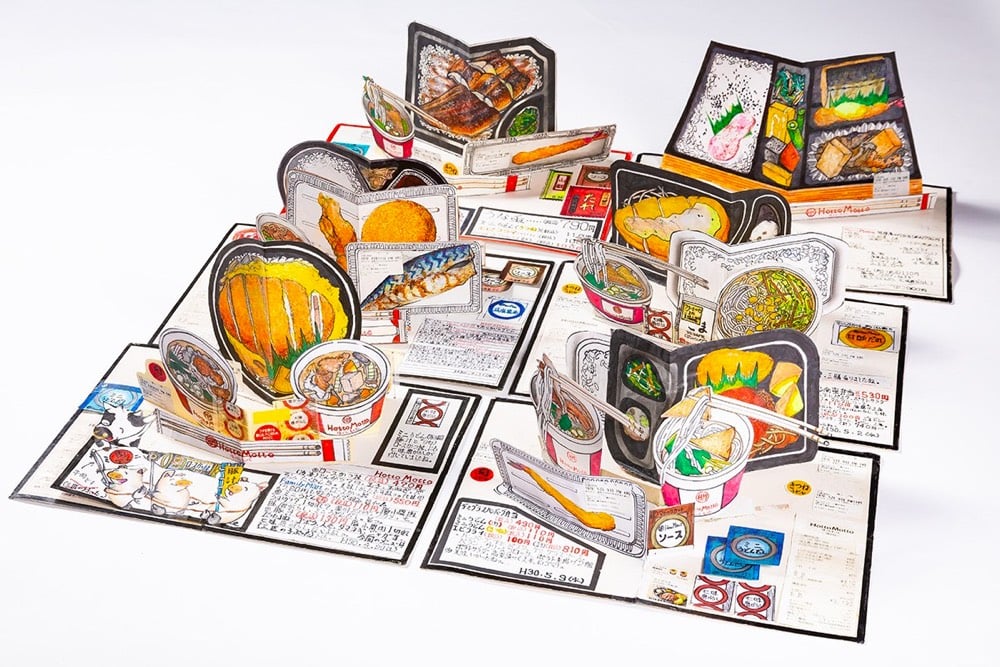
For 32 years, Itsuo Kobayashi has been painting top-down pictures of the meals he eats. The paintings are accompanied by descriptions of each meal. Kobayashi worked as a chef for years until he suffered an illness that left his movement impaired, causing him to double-down on his art.
An interview with Estelle Caswell, creator of Vox’s excellent Earworm video series. The bit about YouTube demonetizing their videos is infuriating. “YouTube’s content ID algorithm has no idea what fair use is.”
I love this: The Pudding is testing the “infinite monkey theorem” by having a computer program randomly try to play the first notes of familiar songs. The Imperial March from Star Wars took ~1.3 billion attempts to get right.
The Art of the New Deal: Why the Federal Government Funded the Arts During the Great Depression. “He turns the question about who ‘deserves’ relief on its head. Dance may not be necessary by some people’s lights but eating most certainly is.”
Not liking the thing that everyone else is (very publicly) loving can be a tough row to hoe. “It seems like everyone in the world loves [Fiona Apple’s] “Fetch the Bolt Cutters.” So why don’t I? On the isolation of disconnection.”
Daniel Radcliffe Reads the First Chapter of Harry Potter and the Sorcerer’s Stone
As part of the Wizarding World’s Harry Potter at Home initiative, they’re having an all-star cast read the first book in the series aloud on video. The first chapter was just released and it’s read by none other than Daniel Radcliffe himself. You can also listen on Spotify:
A new chapter with a different reader will be released each week — readers of future chapters include Stephen Fry, Dakota Fanning, and Eddie Redmayne.
Update: The next few chapters have been released: Noma Dumezweni’s chapter 2, Eddie Redmayne reads chapter 3, and Stephen Fry does chapter 4. The kids and I have been listening to this on Spotify in the car and we’re loving it. I liked Redmayne’s narration the best so far and Fry does an uncanny impression of Robbie Coltrane’s Hagrid voice.
Recent testing shows a man tested positive for Covid-19 in France in late December 2019. “The absence of a link with China and the lack of recent travel suggest that the disease was already spreading among the French population at the end of Dec 2019.”
The Missing Sounds of New York
The NYPL has released an album of sound-based experiences that you might be missing right now as we all shelter at home: Missing Sounds of New York.
It’s a short album (16 min) and includes soundscapes like Serenity Is a Rowdy City Park, I’d Call a Cab to Anywhere, and The Not-Quite-Quiet Library.
See also this 3+ hour album of ambient city sounds. There are also many videos of ambient city sounds on YouTube, like this 10-hour video of ambient NYC sounds:
This is a mix of ambience sounds recorded around Christmas Eve as well as St Patrick’s Day. Enjoy the sounds of people talking, traffic noises, police sirens, subway sounds, footsteps around NYC. City sounds at night and day.
Or perhaps you’d like to go for a stroll in the city instead? (via the morning news)
The Plan Is to Have No Plan
This short description by Jay Rosen accurately describes the Trump administration’s plan for dealing with the Covid-19 pandemic.
The plan is to have no plan, to let daily deaths between one and three thousand become a normal thing, and then to create massive confusion about who is responsible — by telling the governors they’re in charge without doing what only the federal government can do, by fighting with the press when it shows up to be briefed, by fixing blame for the virus on China or some other foreign element, and by “flooding the zone with shit,” Steve Bannon’s phrase for overwhelming the system with disinformation, distraction, and denial, which boosts what economists call “search costs” for reliable intelligence.
Stated another way, the plan is to default on public problem solving, and then prevent the public from understanding the consequences of that default. To succeed this will require one of the biggest propaganda and freedom of information fights in U.S. history, the execution of which will, I think, consume the president’s re-election campaign.
While his actions often have complex effects, Trump has never been a complicated person. This “plan” fits with what we know about Trump’s personality & behavior, plays to his strengths by relying on reactions & tactics and not strategy, is consistent with Occam’s razor, allows his administration to continue pursuing his aggressive agenda (restricting immigration, strengthening big business, weakening public institutions, enriching himself, consolidating power, getting re-elected), and whips his base into a frenzy. As Dave Eggers put it in a satirical opinion piece for the NY Times:
Having no plan is the plan! Haven’t you been listening? Plans are for commies and the Danish. Here we do it fast and loose and dumb and wrong, and occasionally we have a man who manufactures pillows come to the White House to show the president encouraging texts. It all works! Eighteen months, 800,000 deaths, no plan, states bidding against states for medicine and equipment, you’re on your own, plans are lame.
There’s no galaxy brain here, only a twitchy muscle attached to a frayed nerve.
Have a Good Trip: Adventures in Psychedelics
Have a Good Trip is an upcoming Netflix documentary about tripping on psychedelics, like a celebrity/comedy version of Erowid’s drug trip report database.
Mixing comedy with a thorough investigation of psychedelics, HAVE A GOOD TRIP explores the pros, cons, science, history, future, pop cultural impact, and cosmic possibilities of hallucinogens. The film tackles the big questions: Can psychedelics have a powerful role in treating depression, addiction, and helping us confront our own mortality? Are we all made of the same stuff? Is love really all we need? Can trees talk?
The celebs telling their trip stories include Sting, Sarah Silverman, Ad-Rock, and Rosie Perez. I Laughed Out Loud at A$AP Rocky’s short anecdote in the trailer. I hope we’ll hear more about his musical rainbow when Have a Good Trip premieres on May 11.
Some Pandemic Real-Talk from Epidemic Expert Laurie Garrett
This too-short profile of Pulitzer Prize-winning journalist Laurie Garrett, who has been writing about epidemics since the 90s, is closer to my personal feelings as to how the pandemic plays out in the US than almost anything else I’ve read.
But she can’t envision that vaccine anytime in the next year, while Covid-19 will remain a crisis much longer than that.
“I’ve been telling everybody that my event horizon is about 36 months, and that’s my best-case scenario,” she said.
“I’m quite certain that this is going to go in waves,” she added. “It won’t be a tsunami that comes across America all at once and then retreats all at once. It will be micro-waves that shoot up in Des Moines and then in New Orleans and then in Houston and so on, and it’s going to affect how people think about all kinds of things.”
They’ll re-evaluate the importance of travel. They’ll reassess their use of mass transit. They’ll revisit the need for face-to-face business meetings. They’ll reappraise having their kids go to college out of state.
Much of the federal government’s response has been to help big business, and the wealthy are going to have opportunities to not only ride out the storm more easily but to take advantage:
If America enters the next wave of coronavirus infections “with the wealthy having gotten somehow wealthier off this pandemic by hedging, by shorting, by doing all the nasty things that they do, and we come out of our rabbit holes and realize, ‘Oh, my God, it’s not just that everyone I love is unemployed or underemployed and can’t make their maintenance or their mortgage payments or their rent payments, but now all of a sudden those jerks that were flying around in private helicopters are now flying on private personal jets and they own an island that they go to and they don’t care whether or not our streets are safe,’ then I think we could have massive political disruption.”
I could quote something from just about every paragraph, but for now I’ll just do one more excerpt and you can go and read the rest.
Garrett recounted her time at Harvard. “The medical school is all marble, with these grand columns,” she said. “The school of public health is this funky building, the ugliest possible architecture, with the ceilings falling in.”
“That’s America?” I asked.
“That’s America,” she said.
See also Dave Eggers’ pandemic Q&A, which shares a certain pessimistic honesty with Garrett’s thoughts.
An honest pandemic Q&A with Dave Eggers. “Having no plan is the plan! Haven’t you been listening? Plans are for commies and the Danish. Here we do it fast and loose and dumb and wrong…”
The Man Who Runs 365 Marathons a Year. “People are capable of way more than they think they are.”
What Happens Next? Our Possible Covid-19 Futures…
Creative technologist Nicky Case and epidemiologist Marcel Salathé have teamed up to produce a concise but thorough playable explainer about important epidemiological concepts, how we could/should respond to the Covid-19 pandemic, and different scenarios about what the next few years could look like.
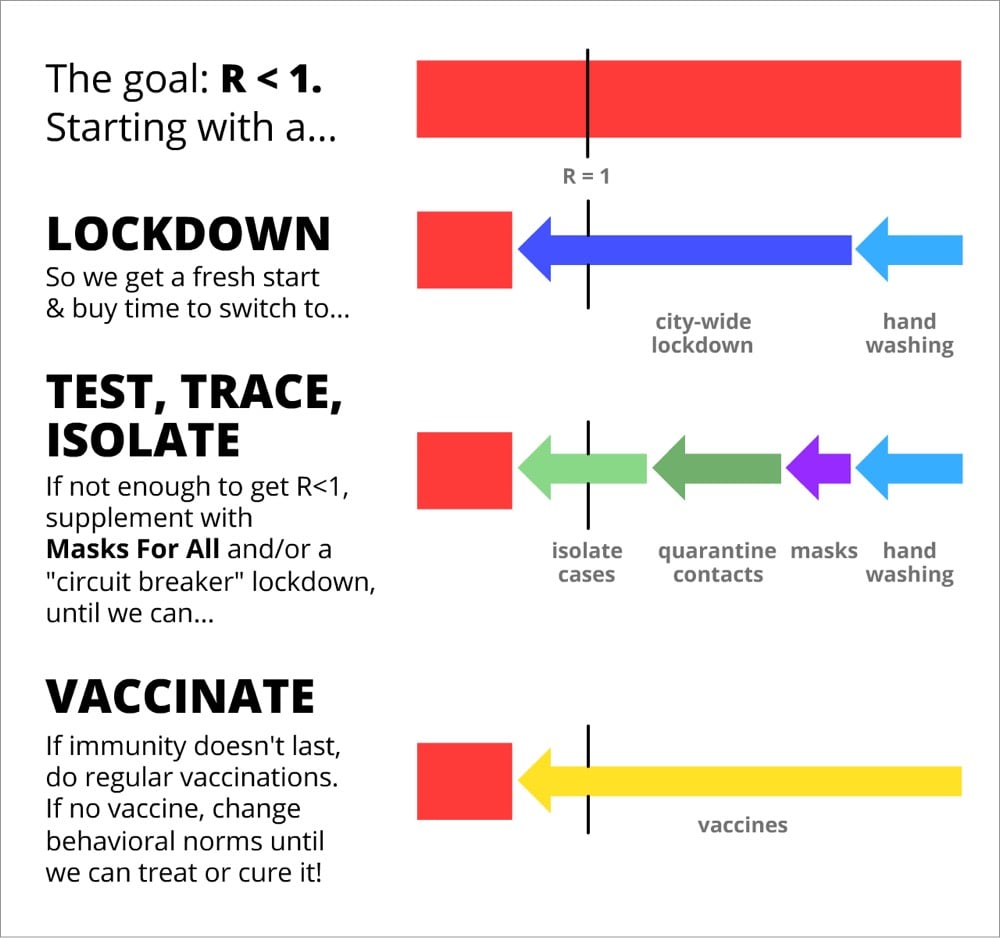
If you’ve been keeping up with the various models and experts’ plans (test/trace/isolate, etc.), there’s not a lot new here until close to end, but it is pretty comprehensive and the playable simulations are really useful. The whole thing takes about 30 minutes to get through, but at the end, you will have an excellent simplified understanding of what this virus could do to us and what we can do to mitigate its effects.
Isolating symptomatic cases would reduce R by up to 40%, and quarantining their pre/a-symptomatic contacts would reduce R by up to 50%:
Thus, even without 100% contact quarantining, we can get R < 1 without a lockdown! Much better for our mental & financial health. (As for the cost to folks who have to self-isolate/quarantine, governments should support them — pay for the tests, job protection, subsidized paid leave, etc. Still way cheaper than intermittent lockdown.)
The problem with this explainer, as excellent as it is, is the problem with all of these plans: many government officials on both the state & federal level don’t seem interested in listening to the experts. It is also unclear — if the unmasked crowds gathering in American cities during this past weekend’s warm weather are any indication — that Americans will be willing to take the steps necessary to keep each other safe. I’m not sure what it’s going to take to address those situations, but I don’t think playable graphs are going to help that much.
Juilliard Students Go All Out for Online Performance
Like other schools, performing arts conservatory The Juilliard School is closed due to the pandemic. But constraints drive creativity, and a group of dance, drama, and music students at the school (along with some alumni like Yo-Yo Ma, Laura Linney, Patti LuPone, and Itzhak Perlman) have created this wonderful performance of Ravel’s Bolero, each performing from their own home.
This is one of the best and most creative grid music videos I’ve seen. The meeting through the glass at 3:40 was genuinely moving. You can read about how the performance came together.
Created with the support of a roster of internal producers, staff, and faculty members as well as a team of external artistic and technical personnel, Bolero Juilliard is a complex online puzzle with many components being conceived, rehearsed, and produced simultaneously. Keigwin and his co-choreographer, Nicole Wolcott, created a storyboard based on states of being and emotional concepts like “Interior Lives” or “Soothing.” Juilliard dancers learn Keigwin’s choreography in Zoom sessions, creating a simulacrum of unity and cohesion very much in spite of the reality of social isolation. Juilliard actors, singers, and alumni contribute videos of emotionally specific gestures and actions. Rather than gathering in-person as they normally would, members of the Juilliard Orchestra and Juilliard Jazz — from wherever they happen to be — video-record themselves playing individual lines, which are edited together to create a complete piece from disparate parts.
The problem with “natural” herd immunity & Covid-19 is that millions will die. “If the pandemic went uncontrolled in the United States, it could continue for months after herd immunity was reached, infecting many more millions in the process.”
“The world is on lockdown. So where are all the carbon emissions coming from?” Emissions have only dropped 5.5%. At this pace, even if the pandemic lasted for years, it wouldn’t be enough to keep the world under 1.5°C of warming.
This article’s title contains the phrase “Murder Hornet”. I needn’t say anything more – you’re either going to click or not.
My Recent Media Diet, The Pandemic Edition
Well, it has been awhile. I have not done one of these since late December. First I was away for a few weeks and then, well, you know. I’m not even sure if anyone wants to read this sort of thing right now — I barely wanted to write it — but I know a lot of people are stuck at home, looking for stuff to watch, read, and listen to. Plus, keeping the media diet going feels normal, at least a little.
If you’re strapped for time/attention, my top recs are Portrait of a Lady on Fire, Devs, Exhalation, Little Women, Unbelievable, Future Nostalgia, The Overstory, and You’re Wrong About.
Devs. Fantastic. I loved every minute of this gem. (A)
Unbelievable. Based on a true story. Excellent performances by Toni Collette and (especially) Merritt Wever. (A)
The Report. Also based on a true story. The Bush presidency still does not get the credit in terms of the harm it did, and continues to do, to America. (B+)
Exhalation by Ted Chiang. Killer collection of tech/science stories. (A)
Slow Burn (season 3). Not just about Biggie/Tupac, but about 90s hip-hop & the cultural reaction to it. (B+)
AirPods Pro. Wearing these feels a little like the future. (A)
Aeronauts. Perfectly fine. (B)
Portrait of a Lady on Fire. Straight-up masterpiece. (A)
Don’t F**k with Cats. How on Earth did I not hear anything about this case when it originally happened and why is it not more widely known? A media-obsessed wanna-be serial killer caught by online sleuths? It seems like fiction. (B+)
How to Change Your Mind by Michael Pollan. This maybe would have been better at half the length. (B+)
1917. Technically stunning but I never truly got involved in the story because I was trying to see where the cuts were. (B+)
Icarus. Almost unbelievable where the story goes in this. (A-)
Little Women. My choice for the best 2019 movie. (A)
My Brilliant Friend (season 2). The second part of the first season set a high bar to clear, but I’m loving this season so far. (A)
Jojo Rabbit. Like Inglourious Basterds directed by Wes Anderson. (A-)
On Earth We’re Briefly Gorgeous by Ocean Vuong. Fittingly finished this on the plane to Vietnam. (B+)
Anthropocene. Typically excellent look at the impact of humans on the Earth by Edward Burtynsky. (A-)
Frances Ha. Baby Adam Driver! (B+)
Catch Me If You Can. Spielberg (and DiCaprio) at their most entertaining. (A-)
Edge of Tomorrow. Love this movie. An underrated gem. (A)
The Overstory by Richard Powers. A wonderful novel about trees and the natural world. (A)
Titanic. A masterclass of blockbuster filmmaking and storytelling. (A)
Good Place (season 4). Loved the ending to this. (A-)
Outbreak. Contagion. Deep Impact. 2012. The Core. I Am Legend. I have been watching all of the disaster movies. They are terrible and I love them. (A/C-)
The Aftermath. The ending of this felt random, a gotcha to the audience rather than the natural end to the story. (B)
Breakfast, Lunch & Dinner. I had medium hopes for this, but the Seth Rogan episode made me laugh harder than I have in months. (B+)
Watchmen. The first three episodes gave me this-is-gonna-end-like-Lost vibes and then they announced there wasn’t going to be second season, so I stopped watching. (B-)
The Farewell. Wonderful. (A-)
A Shaun the Sheep Movie: Farmageddon. Started slow but finished strong. Keep your eyes peeled for all of the sci-fi references. (B+)
Birds of Prey. This was mindless. And not in a good way. (D)
McMillion$. My main takeaway was being aghast at how much time, energy, and money the FBI put into this case, which one of the lead investigators only pursued because it was fun. (B)
Star Trek: Picard. I would have voted against bringing this beloved character back (for fear they’d ruin it) but I enjoyed almost every second of this. (B+)
The Splendid and the Vile by Erik Larson. Another great book from Larson. The Battle of Britain is surprisingly relevant to these pandemic times. (A-)
Onward. Not my favorite Pixar, but solid as always. (B)
Future Nostalgia. Love this album, not a single weak song. (A)
The Mandalorian. It took me too long to realize that this was a western. I don’t care that much for westerns. (B)
Star Wars Episodes I II III. I needed some true garbage to watch about two weeks into my self-quarantine. These movies are mostly terrible. (C-)
You’re Wrong About. I’ve mentioned this podcast before, but You’re Wrong About has become essential listening for me. The OJ and DC Sniper series are both great, and their episode Why Didn’t Anyone Go to Prison for the Financial Crisis was excellent and surprisingly didn’t really mention the actual crisis at all. (A)
Iron Man. Iron Man 2. Thor. Captain America: The First Avenger. The Avengers. The kids and I are rewatching all the MCU movies in release order. Some are better than others. (B)
Tiger King. I watched the first episode and…is this anything more than just gawping at yokels? Does this documentary have anything important to say about society or is it just reality TV? (C)
LBJ and the Great Society. A fascinating look at a brief moment in time when our government worked and how that happened. (A-)
The Case of the Missing Hit. You’ve likely heard this instant-classic episode of Reply All by now, but if you haven’t, it’s worth the hype. (A-)
Tempest in a Teacup. Outside/In talks to Charles Mann about a passage in 1491 about passenger pigeons, which suggested that their famous abundance was a relatively recent occurence caused by the decimation of indigenous populations in the Americas by Europeans and their diseases. (B+)
The Living Room. The episode of Love + Radio that inspired the Oscar-winning The Neighbor’s Window. (A-)
Simulcast. Tycho’s instrumental companion album to Weather. (B+)
Minority Report. This was cheesier than I remembered it. Hasn’t aged well in some ways. (B)
Pelican Brief. So 90s. But I’d forgotten the star power of Denzel and Julia Roberts, even in a mediocre movie. (B)
Murder on the Orient Express. Rewatch. Branagh sure does chew the scenery, but it is fun to watch. (B+)
Gemini Man. Action. Sci fi. Mostly forgettable. (B-)
Yesterday. Cute flick. (B)
Monsters University. This was the only Pixar movie I had never seen. And now I have. (B)
Dark Phoenix. Slightly more entertaining than I was expecting. (B)
Past installments of my media diet are available here.
What to Ask Instead of ‘How Are You?’ During a Pandemic. “Everyone’s doing badly. We need better questions to ask.”
Jim Henson Demonstrates How to Make Your Own Puppets
In this charming video from 1969, right before Sesame Street premiered on PBS, Jim Henson spends about 15 minutes showing how to make simple puppets out of materials you might have handy at home: cardboard, plastic cups, fabric, wooden spoons, potatoes, etc. Joining him was the designer of the Muppets, Don Sahlin.
He is “the inventor” of the Muppet look, from a design point of view. As discussed in the book Jim Henson’s Designs and Doodles, many of the Muppets began as Henson’s rough sketches, which Sahlin then built and modified as needed… Sahlin was known to refer to himself as the “guardian of the essence” of the Muppets.
Henson’s Kermit-y voice is super soothing. What a great find by the indispensable Kid Should See This.
Zip tie art? Zip tie art!
The Songs of 1984, 1985, 1986, 1987, 1988, and 1989
You might remember last year1 when the Hood Internet released a series of videos mashing up the top songs of 1979-1983. Over the next few weeks, they’re going to finish up the 80s. The video from 1984 is up first:
As previously noted, 1984 was perhaps mass pop culture’s high tide, a great year for music, and the most 80s year of the 1980s.
Update: Here are the videos for 1985, 1986, 1987, 1988, & 1989.
Update: Steve Reidell and Aaron Brink of The Hood Internet talk about how they do these year-by-year mixes.
Oftentimes we’ll have an idea of where we want to start and where we want to end, and the work is figuring out how to get from one place to another. We’re changing song speeds and tempos to match and pulling in individual instrumental or vocal tracks if we can find them. Sometimes the thing that matches is a musical similarity and sometimes it’s lyrical. In the 1981 video, there’s a section where we string together Rick Springfield singing “Jessie’s Girl” and Rick James singing “Superfreak” and made it sound kind of like a duet about the same girl. Dropping that on top of Vangelis’ theme to Chariots Of Fire just ups the intensity and the absurdity of it all.
Update: They’ve released the entire 1979-1989 mix as a continuous mix on Soundcloud.
I know, I probably lost a bunch of you at “remember last year”. But I’m pressing on regardless.↩
Lunar Landing Recreated from Archival NASA Photos
Using thousands of original photographs taken by astronauts during the Apollo missions, motion designer Christian Stangl and composer Wolfgang Stangl worked for 18 months to create this animated short film depicting a flight to the Moon, culminating in a landing and the exploration of the surface. (via moss & fog)
A visualization of wealth shown to scale. 1 pixel = $1000. Keep scrolling through the wealth of Jeff Bezos (it takes awhile). “Jeff is so wealthy, that it is quite literally unimaginable.”




Stay Connected